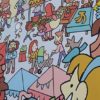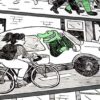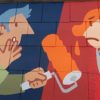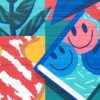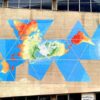MIXITY EUROPEANNESS
« Suis-je européen ? » ? 60 artistes. 60 réponses
60 artistes issus de toute l’Union européenne rechercheront bientôt, au travers d’autant de créations, une réponse à la question « Qu’est-ce que l’identité européenne précisément ? » Les œuvres d’art qui ont été imprimées sur des bâches seront placées sur différents chantiers dans le quartier européen à Bruxelles.
Lire le communiqué de presse

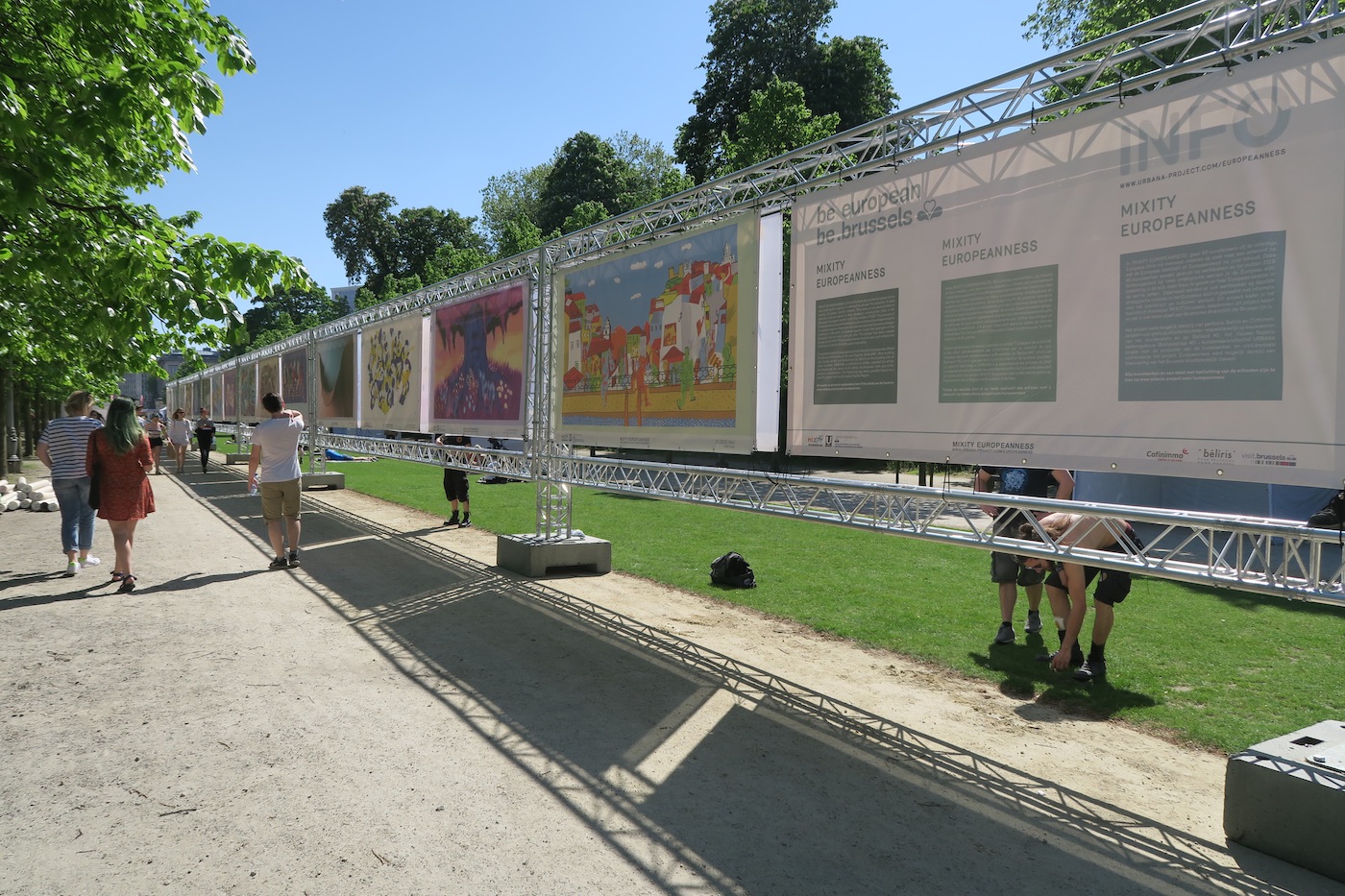



Visages, silhouettes, mains, paroles, et expressions forment une vision de l’Europe complexe dans sa diversité. Un melting-pot culturel constitué par le peuple du vieux continent contemporain mélangé dans un flow vibrant qui embrouille la lisibilité des mots-clés du projet.

Ma photo a été prise à Molenbeek lors de mon projet qui vise à photographier la jeunesse et l’éducation.
Prise lors d’un carnaval cette photo reflète à mon sens un rappel aux étoiles du drapeau Européen ainsi que la joie de vivre ensemble et le plaisir de pouvoir s’amuser sans se soucier de quelle origine nous sommes. J’avais commencé mon projet pour faire contre-attaque aux médias qui pourrissaient la commune de Molenbeek. J’avais décidé de prendre en photo les personnes qui se battent pour faire changer les choses. La vie normale des gens qui habitent un quartier à difficulté sociale.

Ce travail vient de l’idée qu’il existe des identités linguistiques propres à chaque langue européenne. La plupart de ces langues utilisent le même mot pour dire « jouer » de la musique ou « jouer » à un jeu. Dans ma langue, le verbe « jouer » signifie jouer et danser, ce qui est également associé à la musique. Tout le monde pratique la musique, la danse, les jeux et les activités associatives et elles sont positives.
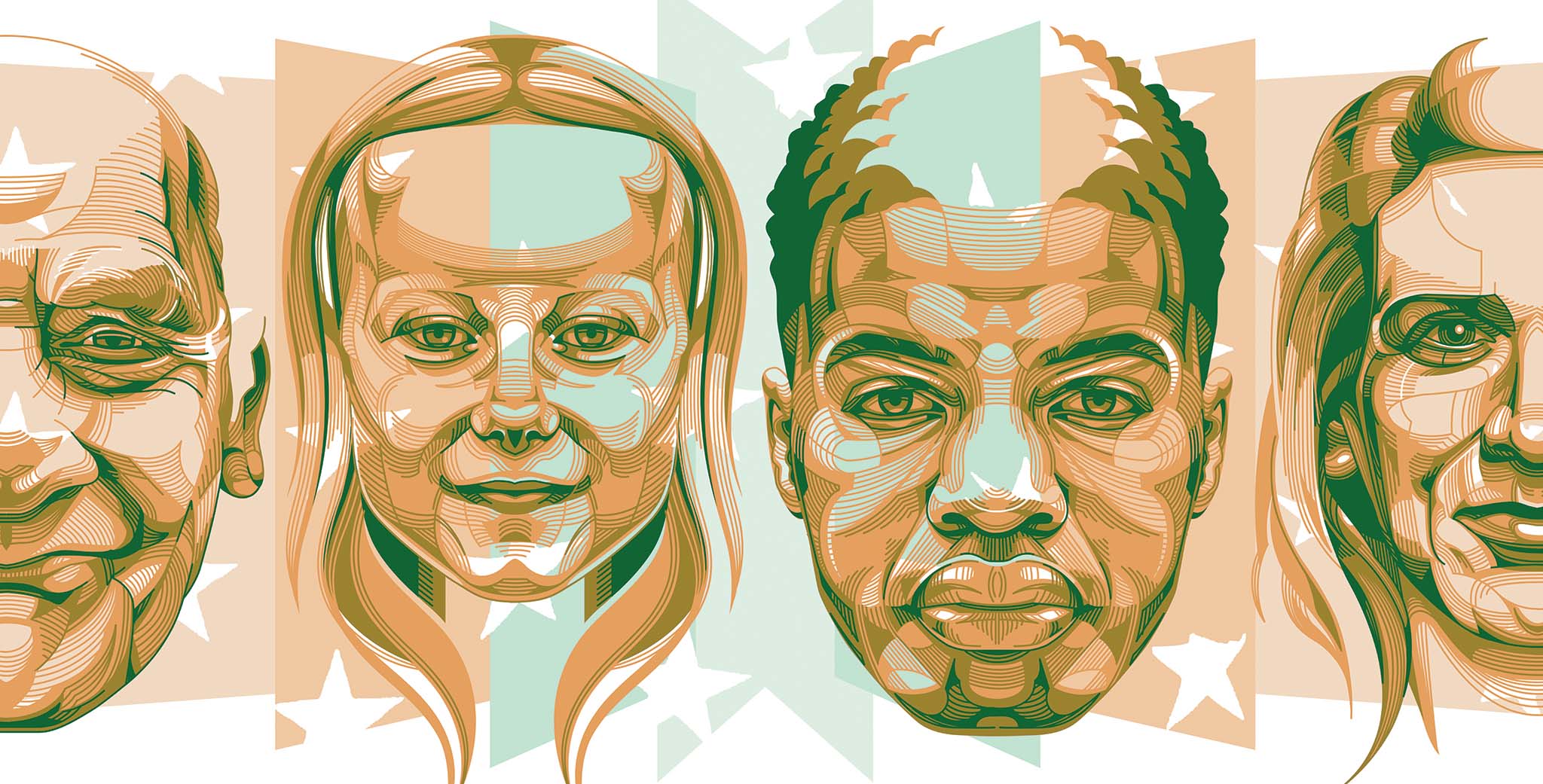
L’objectif de ce travail est de montrer les différents visages, genres, âges, origines qui forment ce magnifique melting pot qu’on appelle Europe. Toutes ces différentes nationalités qui vivent ensemble sur ce même continent. Les étoiles sur le bannière du fond symbolisent l’unité, des étoiles pour des millions de personnes, brillantes, toutes uniques, mais qui ensemble forment un lien très fort.
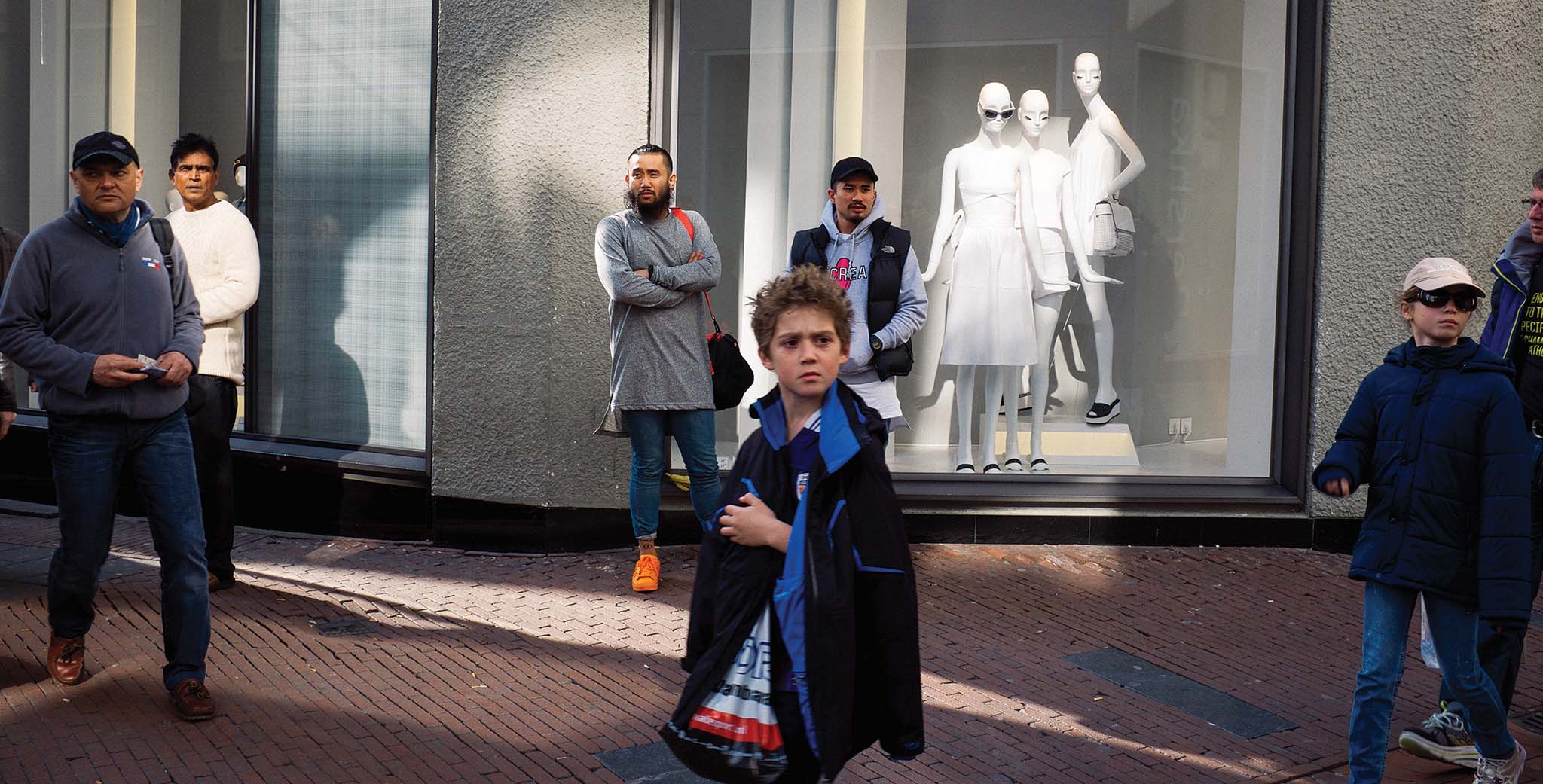
Puisque le paysage culturel et économique n’a de cesse d’évoluer en Europe, nous devons nous rappeler que, bien que nous voyions les choses différemment, au final, ce qui nous mène vers l’harmonie est d’avancer ensemble.
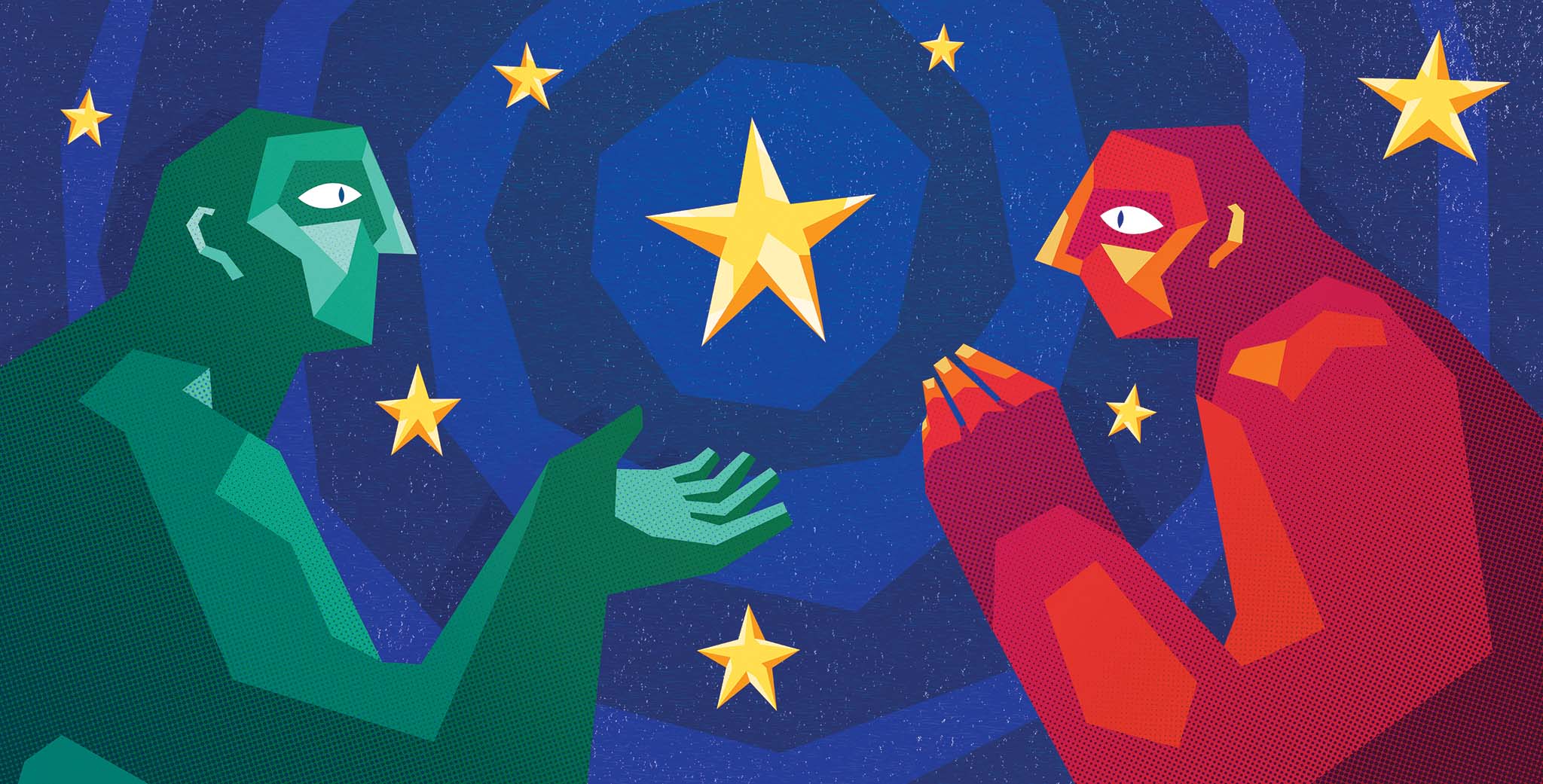
L’Europe est intrigante, tout comme les différentes cultures qui la compose. Elle forme un tout dans lequel nous vivons, ces cultures nous ont construits en tant qu’une seule identité, l’identité Européenne.
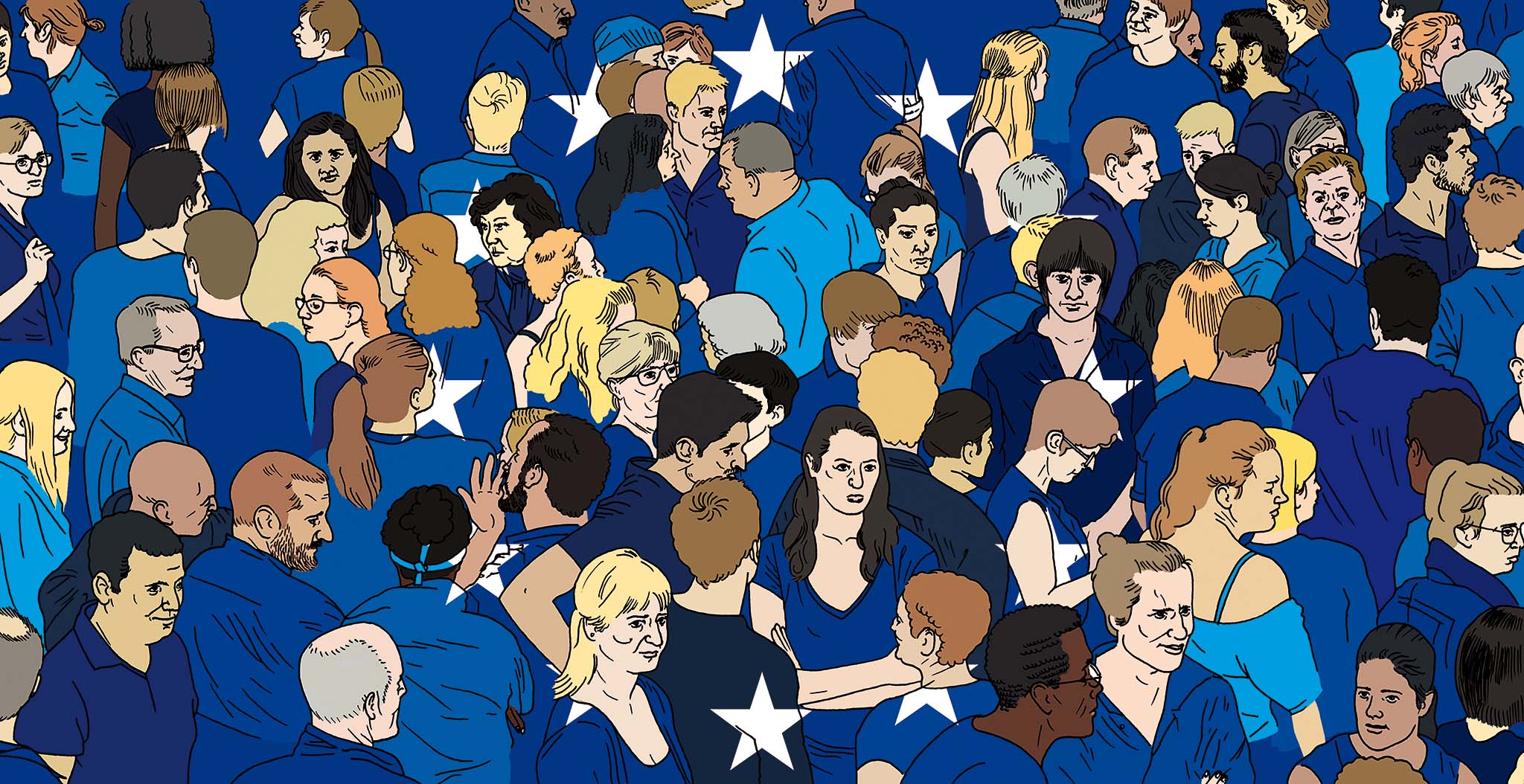
Pour répondre à la thématique de l’identité européenne, j’ai voulu produire une représentation concrète de ce qu’est cette identité, en représentant un rassemblement d’individus issus de l’union européenne. L’alliance des différences, quelles qu’elles soient, étant la base même de l’existence de cet espace géographique et symbolique.
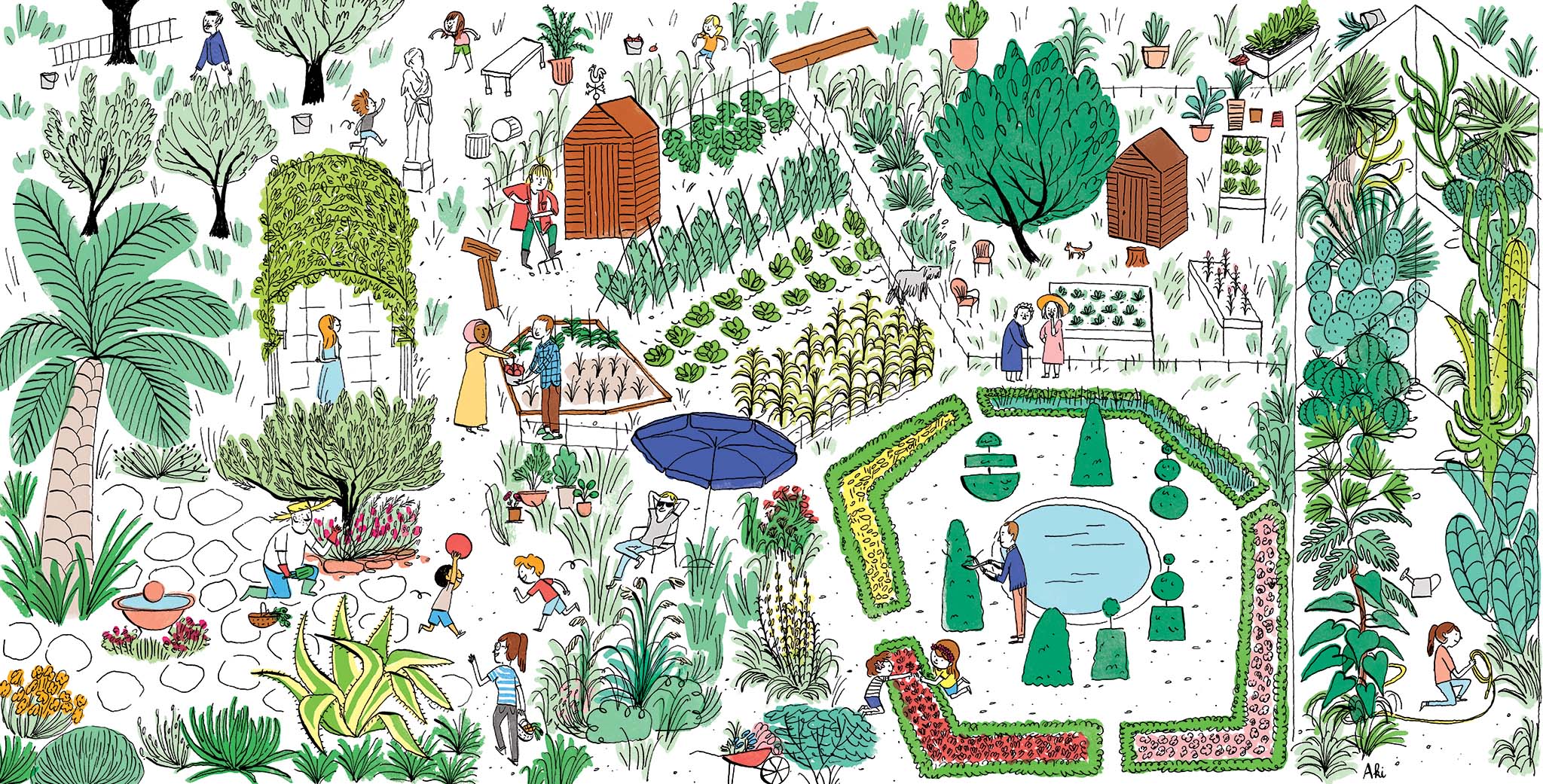
J’ai représenté des jardins partagés. Pour moi c’est une version de l’Europe en miniature, chacun a son jardin mais est proche de ses voisins. On échange, on circule entre, on s’entraide et on se respecte.

Cette image montre que l’Europe est un espace d’expression de joie pour chacun. Je vois l’Europe comme une soirée entre amis Et le message est : « L’Europe offre plein de possibilités, alors profitez-en et amusez-vous ! »

« les voisins »
Ce que j’aime le plus à propos de l’UE est le fait que l’on puisse voyager librement et visiter soit des pays voisins proches, soit des pays plus lointains sans problème. On peut avoir des amis et de la famille qui viennent d’autres pays, on peut revoir un ami de l’autre côté de la frontière et revenir à la maison en toute sécurité et le même jour, on peut travailler à l’étranger, faire partie de projets bénévoles etc. L’Europe nous offre une multitude de possibilités et élargit notre façon de penser. Donc sur cette illustration, j’ai dessiné un voisinage sympathique et un drapeau de chaque pays sur chaque maison, représentant les pays de l’UE. Il y a beaucoup d’interactions entre les voisins – ils s’entraident, passent du temps ensemble, s’invitent les uns les autres, partagent, respectent les règles de chaque maison, etc.

Mon œuvre est basée sur l’idée que des personnes différentes des nations d’Europe apprennent à connaître les cultures et patrimoines des uns et des autres, et se rassemblent pour créer une culture d’acceptation et d’unité. Cette œuvre joue sur le concept d’un potentiel caché et imprévu, et du voyage partagé vers l’inconnu.
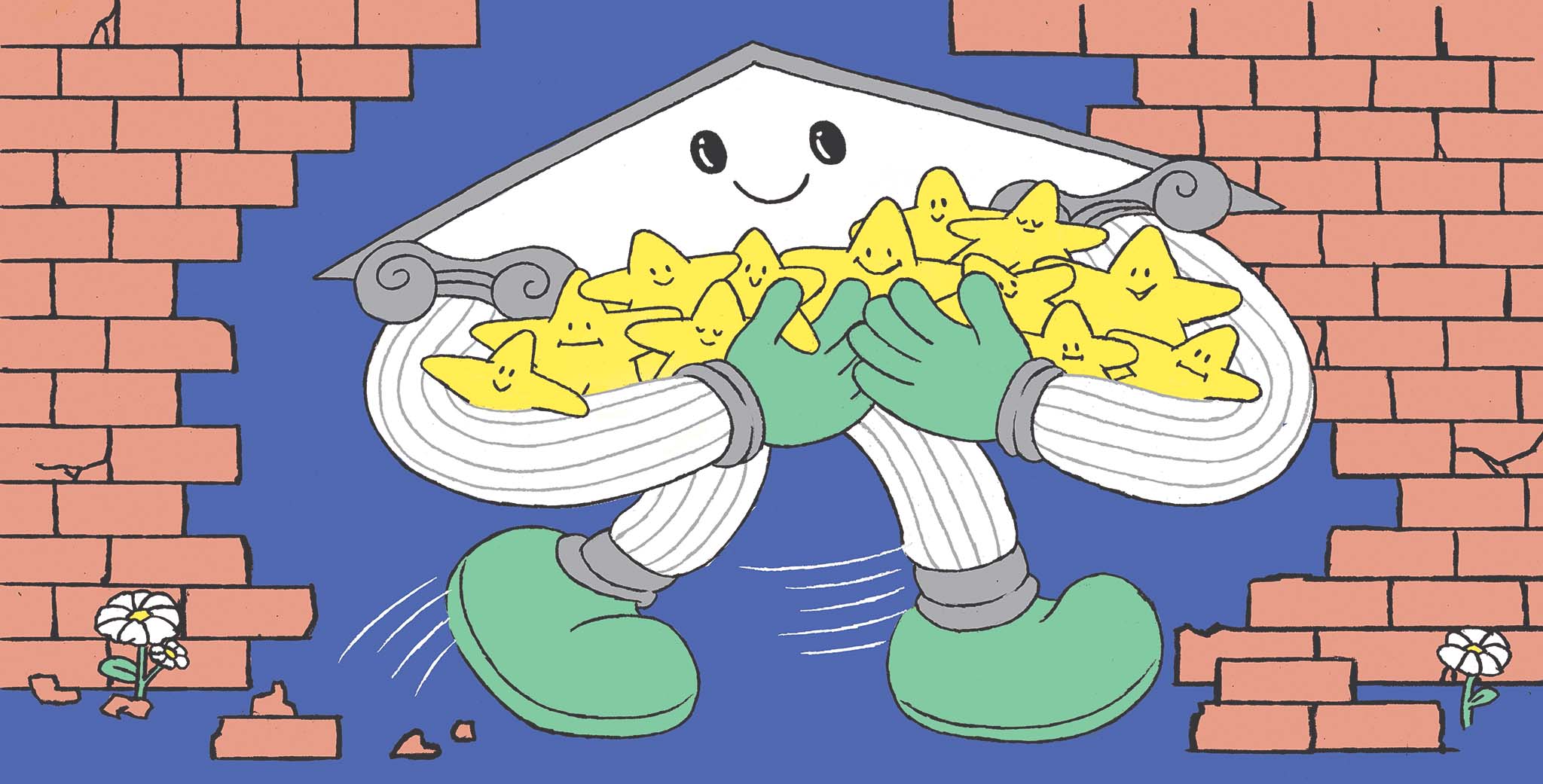
J’ai tenté une réflection sur la situation politique actuelle – où certaines valeurs fondamentales de la démocratie sont en jeu – tout en gardant une vision positive. Le message principal est : restez unis et protégez l’idée de l’Europe et ses valeurs – encore plus en ces temps difficiles. Cela va probablement parler aux enfants et je pense que c’est une bonne chose.
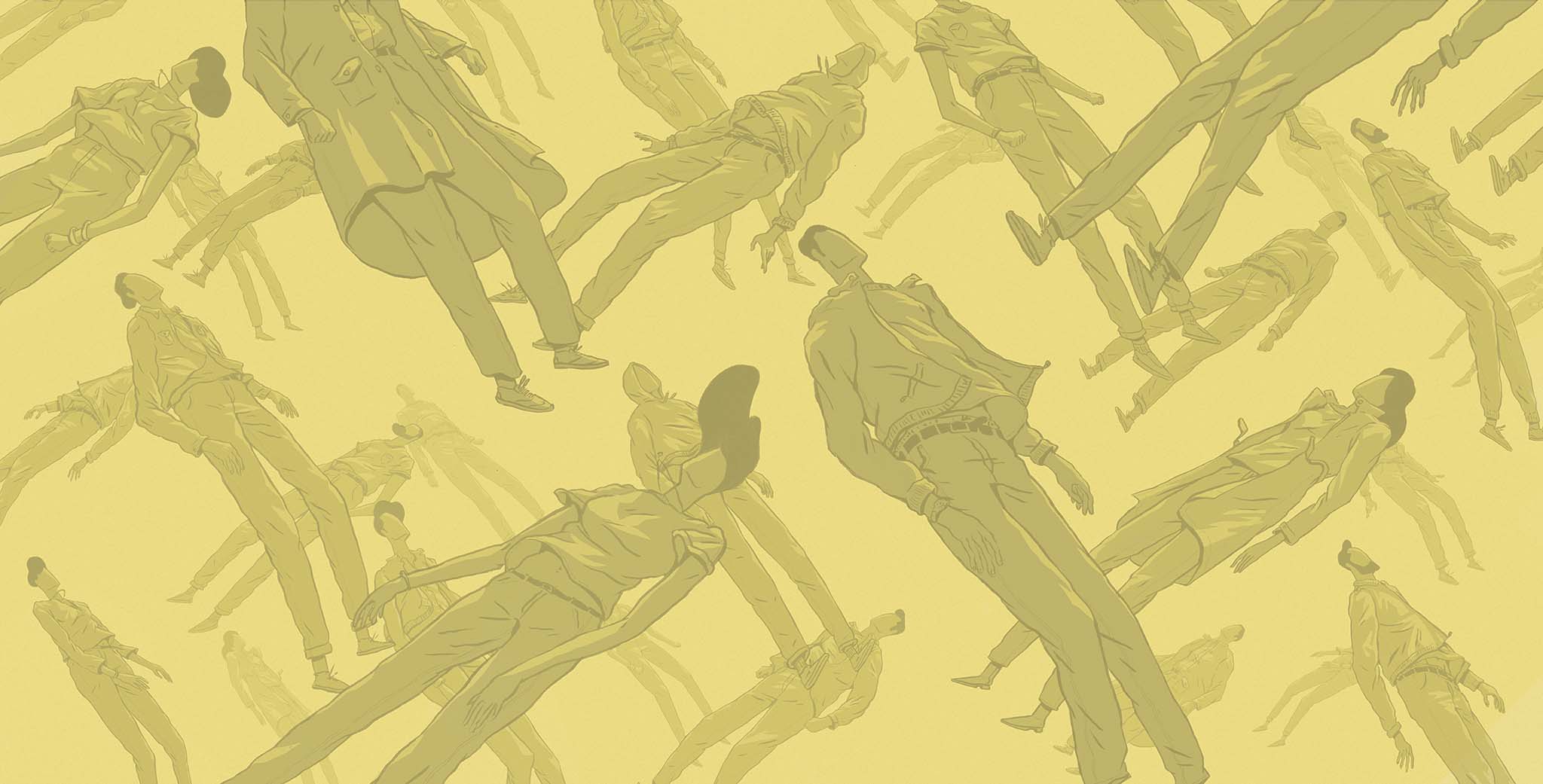
INSIDE ONE OF TWELVE STARS
Des individus flottant dans une dynamique de mouvement, d’échange. La dynamique générale de l’illustration peut représenter l’organisation de l’Europe qui permet aux pays de l’UE de se déplacer librement et ce de manière ordonnée, créant une mixité riche, mais l’idée derrière cette illustration est surtout que chaque individu contribue à créer un plus grand ensemble harmonieux.

J’ai axé mon travail sur la Belgique et Bruxelles car elle représente la base de l’identité européenne, étant la capitale de l’Europe je me suis dit qu’au lieu de représenter certaines villes, autant se baser sur les clichés de notre bonne vieille capitale. La plupart des éléments de cette illustration ont un sens, les deux mains qui s’agrippent représentent l’alliance Européenne qui tient le coup malgré de nombreuses fractures (symbolisées par le bras qui se sépare)

L’Europe est un continent imprégné de traditions qui font de nous des individus uniques. En même temps, nous sommes tous mélangés grâce à la liberté d’aller et venir entre les pays et à mesure que nous apprenons de nos voisins, ils deviennent une part de nous ! Ensemble nous faisons l’Europe !

Pour cette illustration qui se devait de donner un point de vue sur l’identité européenne, j’ai fait un parallèle avec la légende du roi Arthur et de la table ronde, pour plusieurs points, qui me semble bien correspondre à ce qu’est l’UE et comment elle est interprétée.
Pour moi l’UE est comme une quête de vérité, mettre du sens sur quelque chose d’assez indéfinissable au premier abord dans son sens et sa forme, se dévouer à cette forme de devoir car l’on sait au final que cette grande entreprise qui nous dépasse apportera du bon pour le plus grand nombre. C’est un peu ce que voulait accomplir Arthur en convoquant ses chevaliers, sans explication et sans vision globale de la chose il devait croire à quelque chose de noble et de grand (le Graal) à un idéal qui n’apporterait la paix dans le royaume qu’après sa découverte. Par rapport à ça, cette quête constante de paix et de transparence était intéressante vis-à-vis de l’union européenne.
Ensuite ce que je trouvais intéressant, c’était cette idée de la mixité présente pour construire cette UE, ce qu’on retrouve dans la légende de la table ronde à travers les multiples origines des chevaliers, tous de coutumes et de moeurs différentes et pourtant devant mettre en commun leur force, leur savoir et leurs compétences respectives pour avancer. Plusieurs esprits doivent au final en représenter un seul qui parle pour tous et également être la voix de leurs peuples respectifs.
À l’arrière des chevaliers on aperçoit une sorte de machine, c’est de cette façon que j’ai voulu symboliser «la machine UE», un constant équilibre entre feu et froid, toute décision qu’elle soit directe ou indirecte se doit d’être mesurée et réfléchie.
Enfin le paysage en arrière-plan représente le cycle jour-nuit, comme pour définir l’idée qu’on ne sait pas de quoi demain sera fait et que de jour comme de nuit, il faut rester vigilant aux atteintes qui peuvent être faites à cette grande construction européenne et à ceux qui veulent la mettre à mal. Le paysage symbolise la construction, l’avancement et l’évolution comme le long d’un sentier
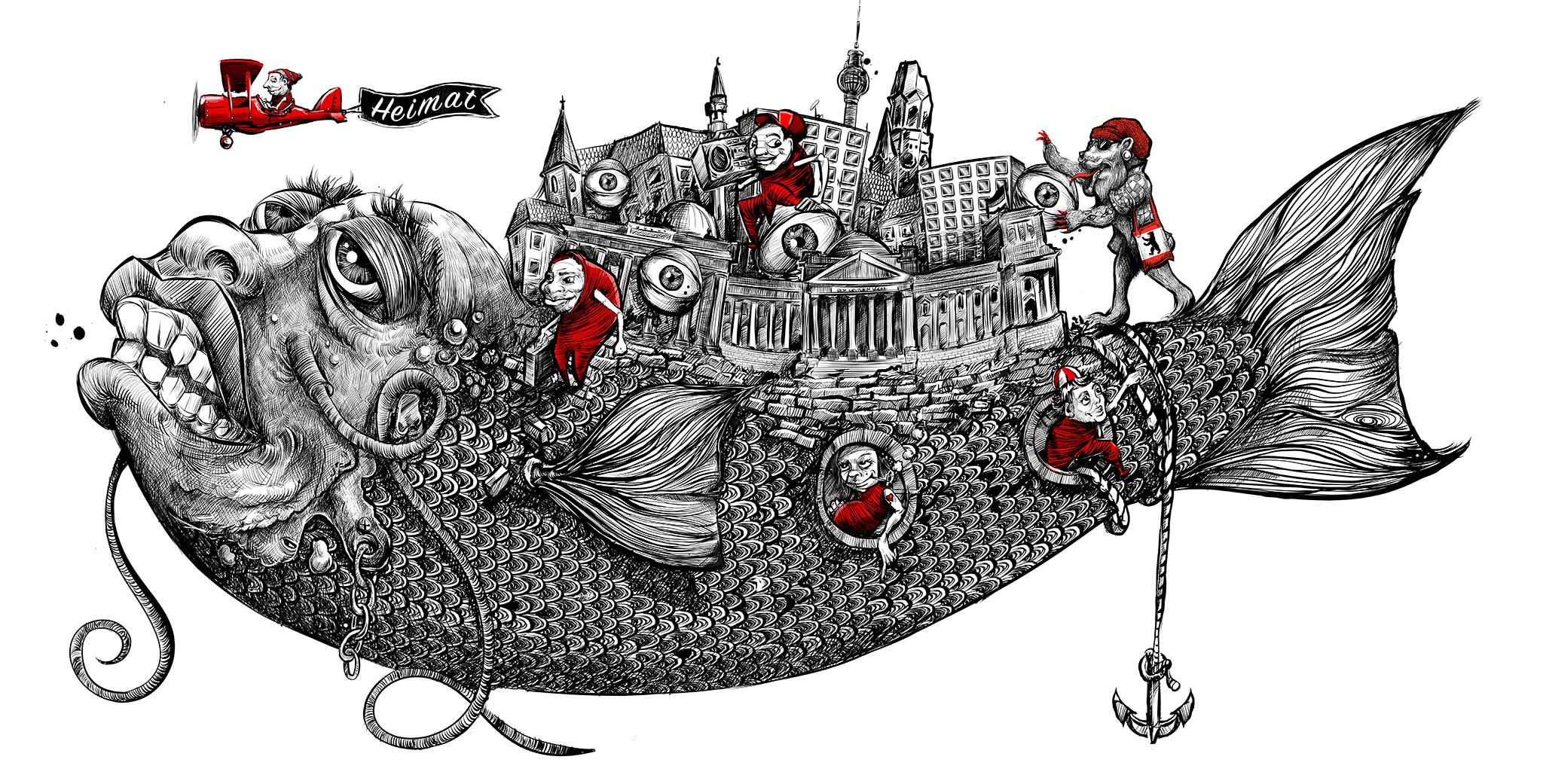
Les maisons derrière le poisson ressemblent à ma maison à Berlin. L’église du Souvenir de l’Empereur Guillaume, l’antenne radio, la porte de Brandenburg etc. Les petits personnages rouges sont comme des petits poissons qui nagent avec le gros poisson.
Je dessine de manière très figurative en tant que personne extérieure à l’Europe. Je nage souvent à contre-courant, sûrement à cause de ma différence culturelle, des obstacles que j’ai pu rencontré et de ma langue. Mais je surmonte les obstacles et suis récompensé à la fin du voyage en recevant une identité européenne. Le poisson porte aussi un poids lourd sur son dos, un fardeau. Même s’il nage dans les mêmes eaux que la société, il porte son bagage avec lui. Ici, les immeubles de la ville de Berlin sont aussi mélangés aux immeubles du Moyen-Orient. Cela montre qu’on peut partager une identité européenne sans pour autant rejeter ou renier ses origines.

Quand j’ai réfléchi à l’idée d’unité en Europe, et les récents événements partout dans le monde, j’ai eu envie de faire une illustration qui encourage l’amour et l’unité entre les personnes venant de cultures et d’horizons divers. J’ai donc entrepris de faire une illustration audacieuse où les individus se fondent les uns dans les autres en formant un cœur.
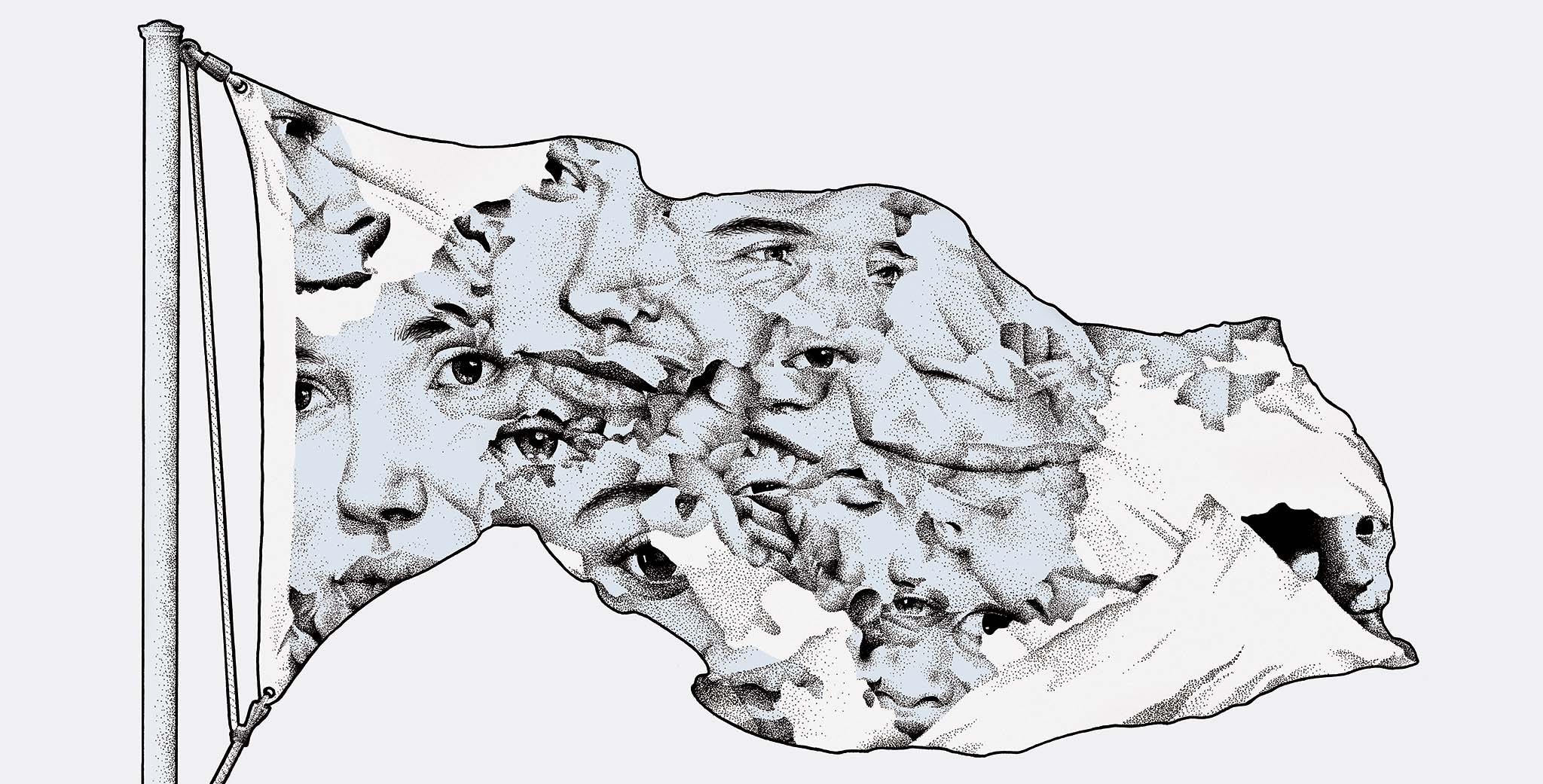
Quand on me parle d’identité Européenne, je pense fusion de toutes les ethnies pour former une seule et même culture. Mon projet rassemble des portraits coupés et emmêlés d’Européens réunis sur un drapeau, qui renforce l’idée de les faire appartenir à une même patrie.
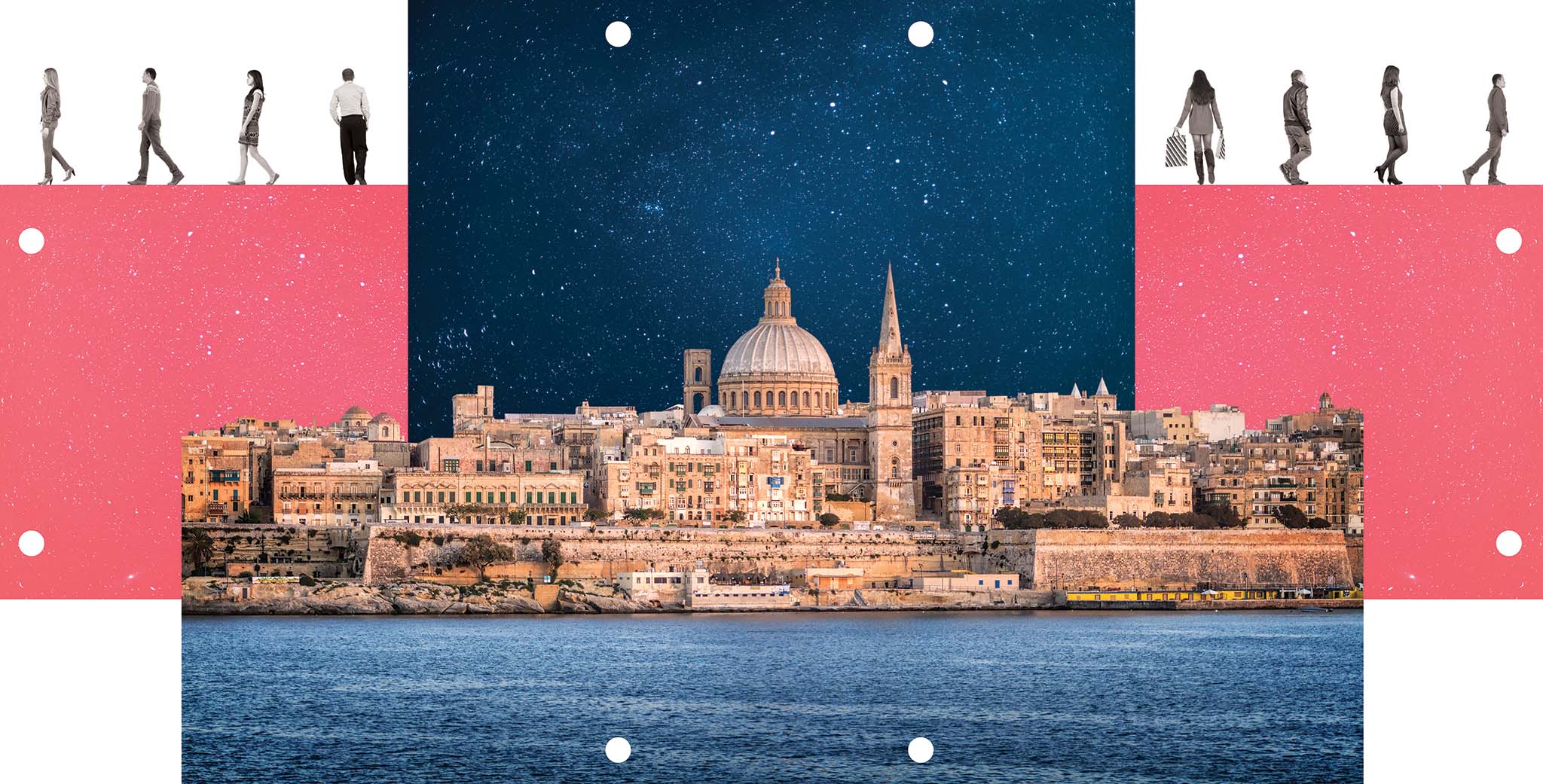
Les personnes (en haut) – Les individus représentant la diversité de Malte se dispersent dans diverses directions car l’Europe offre diverses opportunités d’interagir et d’améliorer nos vies. Il y a aussi autant d’hommes que de femmes, ce qui met en évidence mon prochain point.
La boîte rose – Tout d’abord, j’ai choisi le rose car c’est proche du rouge que l’on retrouve dans notre drapeau national. L’intérêt de choisir cette couleur est de représenter le progrès qui a été fait pour les droits de la femme. Même s’il reste encore des progrès à faire, nous allons dans la bonne direction surtout depuis que nous avons rejoint l’Europe. Sur le même sujet, il y a autant de femmes que d’hommes sur le collage, ce qui représente l’égalité que nous essayons d’atteindre dans les îles maltaises.
Le ciel – Le ciel au milieu s’interprète selon l’expression anglo-saxonne « Sky is the limit » – « les possibilités sont infinies » en français – et montre que les possibilités sont infinies lorsque les individus s’unissent. Sa couleur peut aussi représenter le drapeau européen. Le ciel et la boîte rose forment une croix qui représente la croix de Georges de notre drapeau. Le roi britannique George VI nous l’a donné en 1942 pour « récompenser les actes de bravoures et de courage de certains de ses civils » durant le grand siège qu’ils subirent au début de la Seconde Guerre mondiale.
Le paysage – Le paysage que nous retrouvons dans ce collage est notre capitale, Valletta. C’est une ville riche en histoire et cela peut être vu à travers les différents types d’architecture qui symbolisent l’histoire de Malte et qui ont été influencés par différents dirigeants de différentes parties du monde. Une église est également dominante au milieu du collage représentant les fortes influences catholiques de Malte.
Les 8 Points – Les 8 points (2 de chaque côté) représentent la Croix de Malte à huit pointes, symbole associé aux Chevaliers de Malte qui ont dominé nos îles entre 1530 et 1798.
La mer – La mer devait être incluse car Malte est une île – les îles maltaises – et nous avons aussi une île sœur appelée Gozo. Notre position stratégique a joué un rôle important dans notre histoire car nous sommes situés entre l’Afrique et l’Europe, et c’est l’une des raisons pour lesquelles nous avons une histoire aussi riche et avons fait partie de nombreuses routes commerciales importantes au fil du temps. La mer et notre climat apportent beaucoup de touristes, ce qui constituent le principal revenu de Malte.

Dans ce travail, j’ai mélangé différentes parties du temps ensemble, telle que l’interprétation moderne de la légende grecque ancienne sur le taureau et l’Europe, l’homme du 19e siècle et d’autres personnages faisant des choses différentes mais ensemble.
La description de mon travail est la réponse que j’ai donné à votre devis dans le premier e-mail : « Cette identité européenne n’existe pas au sens classique (géographique, culturelle, linguistique, etc.) mais d’un point de vue plus abstrait, qui se réfère au sentiment d’appartenance à la même communauté résultant du partage des mêmes valeurs et objectifs.
L’identité européenne est en mesure de transcender sa propre diversité. Elle ne devrait pas chercher à se définir ou à se construire contre les identités nationales, mais avec elles. »

Dans cette illustration j’ai décidé de faire le portrait de Georges Brassens et de Fabrizio De André lorsqu’ils interprètent le même morceau, une chanson mélancolique qui, sans rentrer dans les détails, parle de guerre. Écrite par un soldat en temps de guerre, cette chanson est inspirée de toutes les femmes qu’il a connues, celles qu’il a laissées partir, celles qu’il a perdues et retrouvées : une sorte d’invitation à saisir le moment avant qu’il ne disparaisse. Cette chanson a été arrangée par Brassens et est devenue l’une des plus connues du musicien. Par la suite, De André l’a traduite en italien (« d’une manière merveilleuse » comme l’a déclaré Brassens) et l’a rendue populaire avec sa voix puissante en Italie. J’ai choisi de représenter une forte identité européenne liée à l’art et aux artistes, liée à l’échange émotionnel qui nous relie. La volonté de partager le savoir, la culture et l’art sous toutes ses formes. J’ai symboliquement choisi ces deux pays car je suis attaché aux deux, l’Italie comme ma maison, la France comme lieu où j’ai eu la chance de vivre et à laquelle je suis encore attaché émotionnellement.
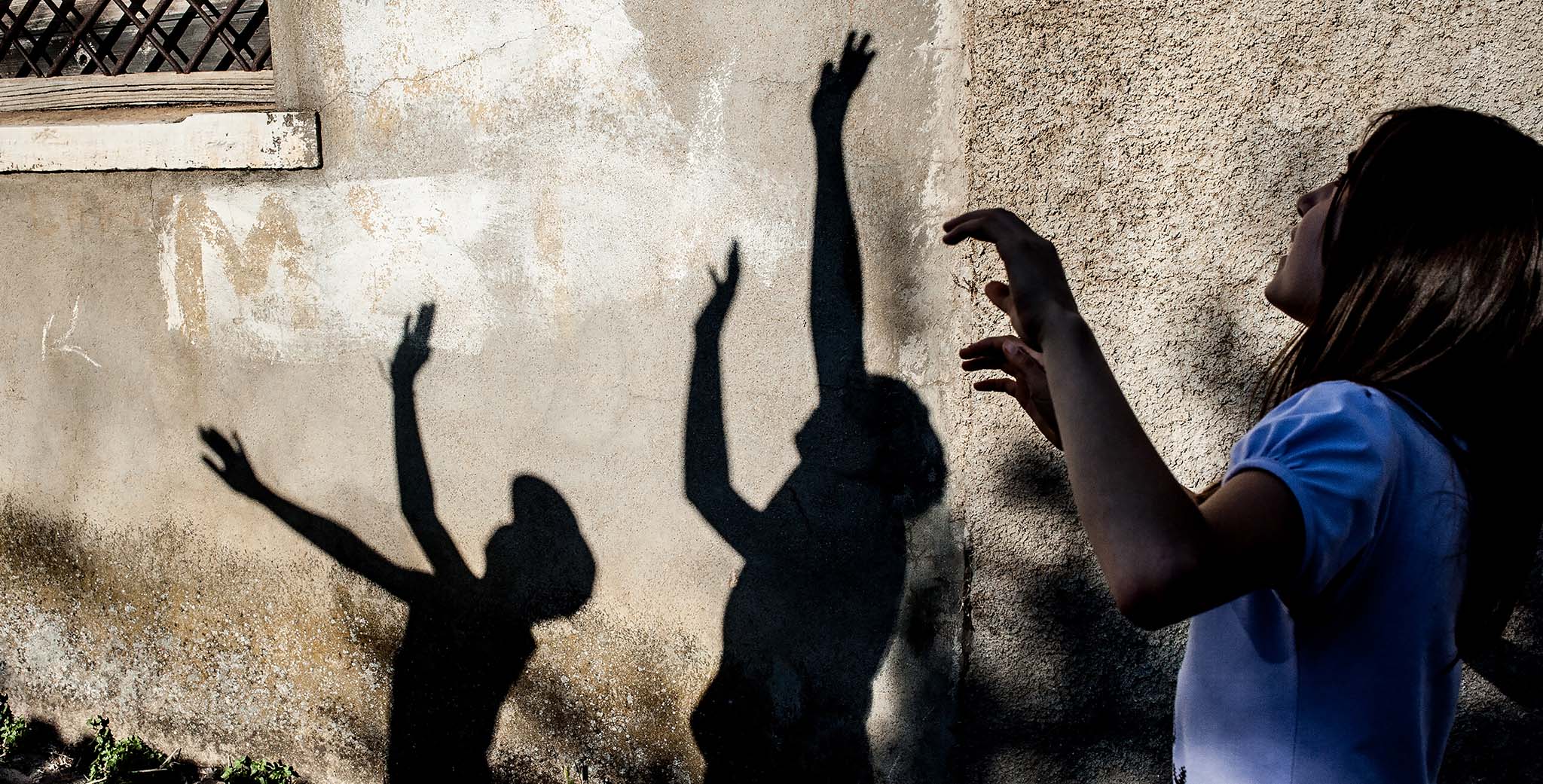
Nous, Européens, trouvons la beauté non seulement dans la chose elle-même, mais dans l’ombre, la lumière et l’obscurité que la chose nous offre. Nos idéaux, comme les images, sont faits d’ombre et de lumière. La plupart des gens pensent que l’ombre suit, précède ou entoure les êtres ou les objets. La vérité est que l’ombre entoure aussi les mots, les idées, les désirs, les actes, les impulsions et les souvenirs. Comme disait Goethe, « Il y a beaucoup d’ombre là où il y a beaucoup de lumière. »
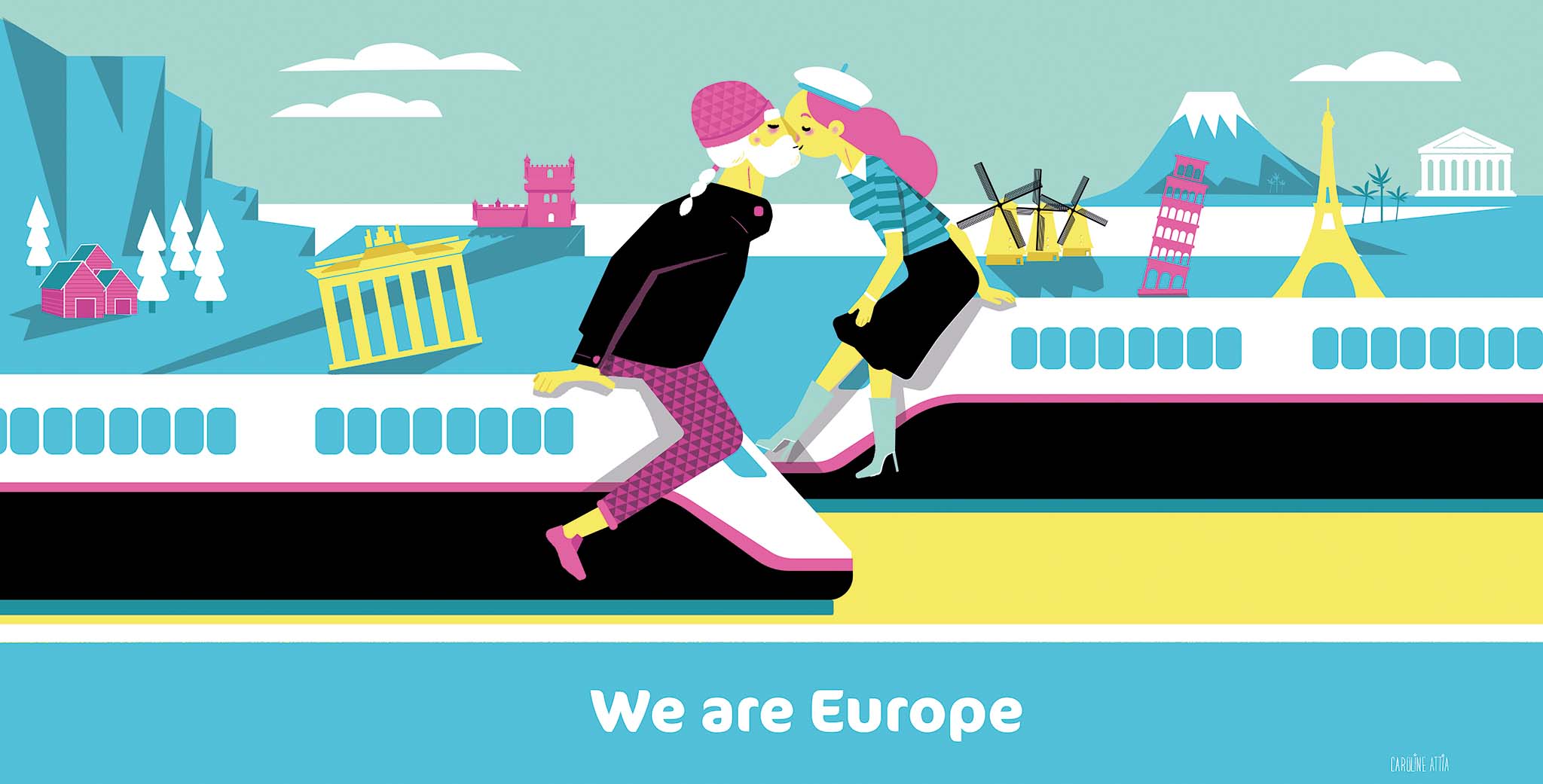
L’Europe c’est l’abolition des frontières. Même si en ce moment, beaucoup tentent de remettre en cause cela, c’est quand même une grande chance d’avoir cet espace de liberté pour voyager. J’aime particulièrement prendre le train pour me déplacer d’un pays à l’autre ( je fais souvent le trajet Paris Bruxelles ou Paris Londres). Le voyage se fait de façon fluide et l’identité européenne c’est aussi cela, ce partage, qui peut créer de belles histoires d’amour par exemple.

Rêver l’Europe, c’est croire qu’un vieux continent comme le nôtre, qui par le passé a connu beaucoup d’horreur, a la capacité à construire quelque chose de meilleur.
Avec tous les membres de cette belle communauté, c’est vouloir que chaque étoile se mette à briller quand il se met à faire nuit.

Waves of Change
Cette histoire commence en 8000 avant JC, lorsque les premiers agriculteurs seraient arrivés sur l’île d’Irlande. S’en sont suivis de nombreux visiteurs venus d’Europe qui ont participé à l’histoire de la petite île et fait de l’Irlande ce qu’elle est aujourd’hui. Dans les Vagues du changement, ils apportent avec eux à travers les mers leurs idées, leurs langues, leurs arts, leurs technologies et leurs nouveaux modes de vie.
Ces visiteurs historiques notables sont représentés visuellement par des personnages. De l’Angleterre et de l’Europe continentale est arrivé le peuple Celte influent. Les chrétiens ont ensuite apporté de nouveaux systèmes de croyance et un art religieux étonnant. De la Scandinavie, les Vikings sont venus par la mer et ont construit notre capitale et introduit des systèmes monétaires. Puis ce fut au tour des Normands de construire de grands châteaux et d’établir de nouvelles coutumes et lancer de nouvelles idées en matière d’agriculture.
Au fil des siècles, notre histoire a été façonnée par le débarquement sur nos côtes de colons européens remarquables. Ils ont intégrés notre nation et aidé notre culture à se forger, en prenant part à notre riche histoire.
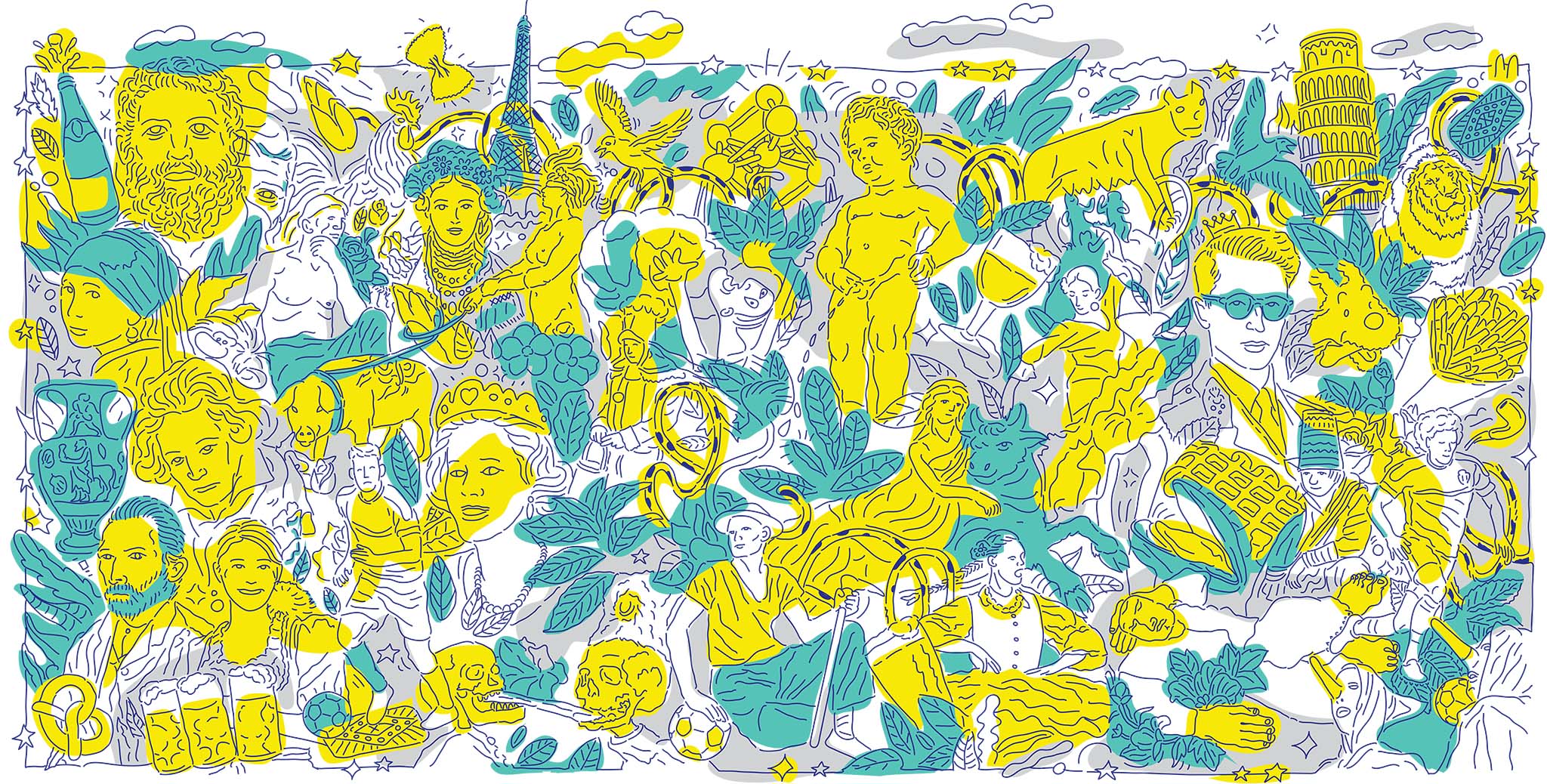
La composition est chargée afin de représenter le foisonnement (culturel, sportif, culinaire…) qui singularise chaque pays de l’union Européenne, les éléments fourmillent et débordent du cadre.
Ces entités nationales se côtoient, s’entrelacent, se juxtaposent dans une composition décloisonnée, les spécificités des différents pays sont associées pour former un tout.
Le cerne est bleu et la couleur dominante du remplissage est jaune, rappelant directement les couleurs du drapeau Européen, la couleur turquoise s’accorde avec les éléments naturels figurant dans la composition.
C’est avant tout en préservant la particularité qui caractérise chaque pays qu’une identité européenne pourra se construire.
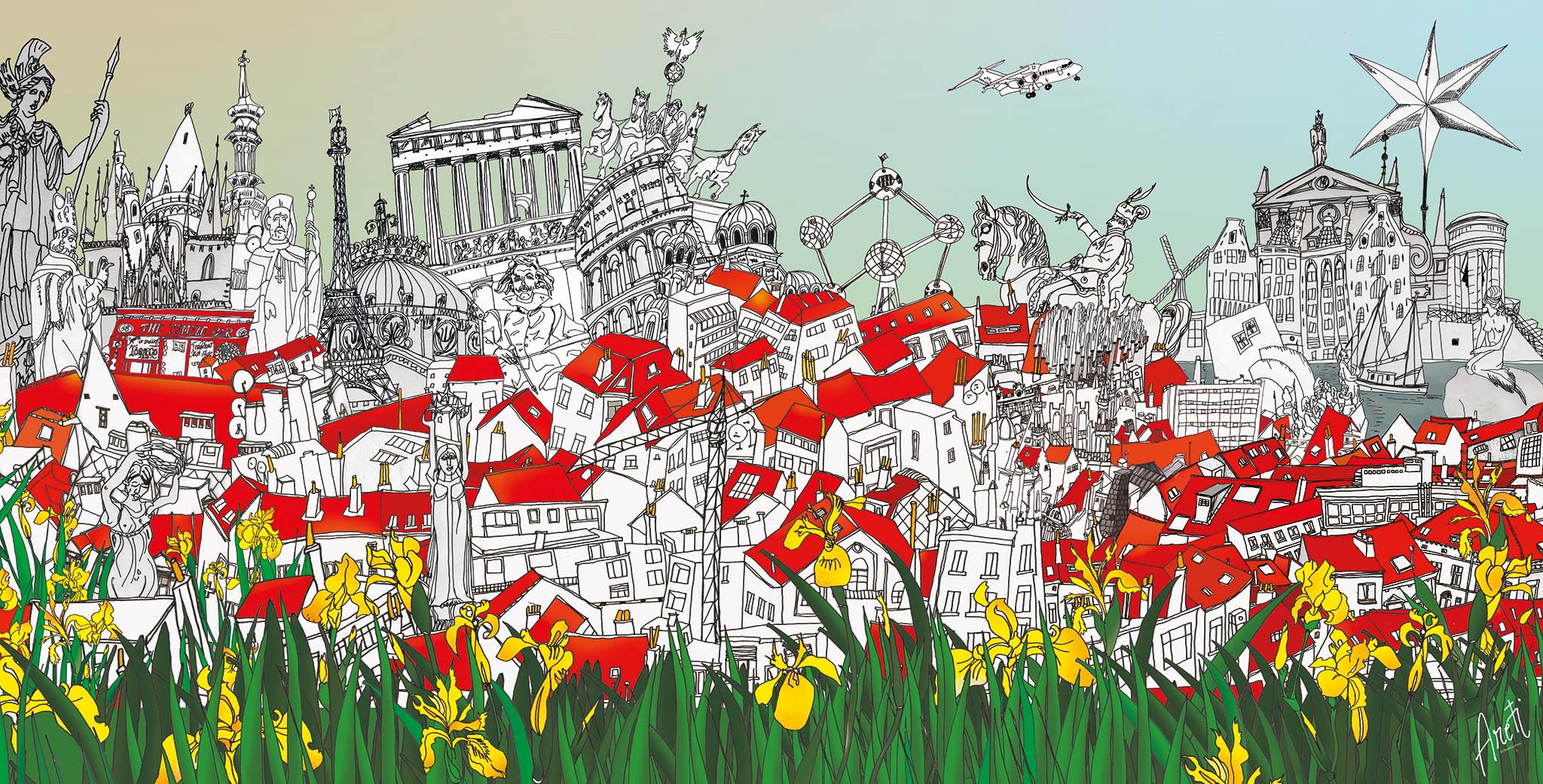
J’ai voulu représenter une image positive de l’Europe, où les différentes villes se mélangent pêle-mêle. Une Europe qui met les habitants à l’avant plan ! Les Iris, quant à eux représentent notre capitale et un nouveau printemps.
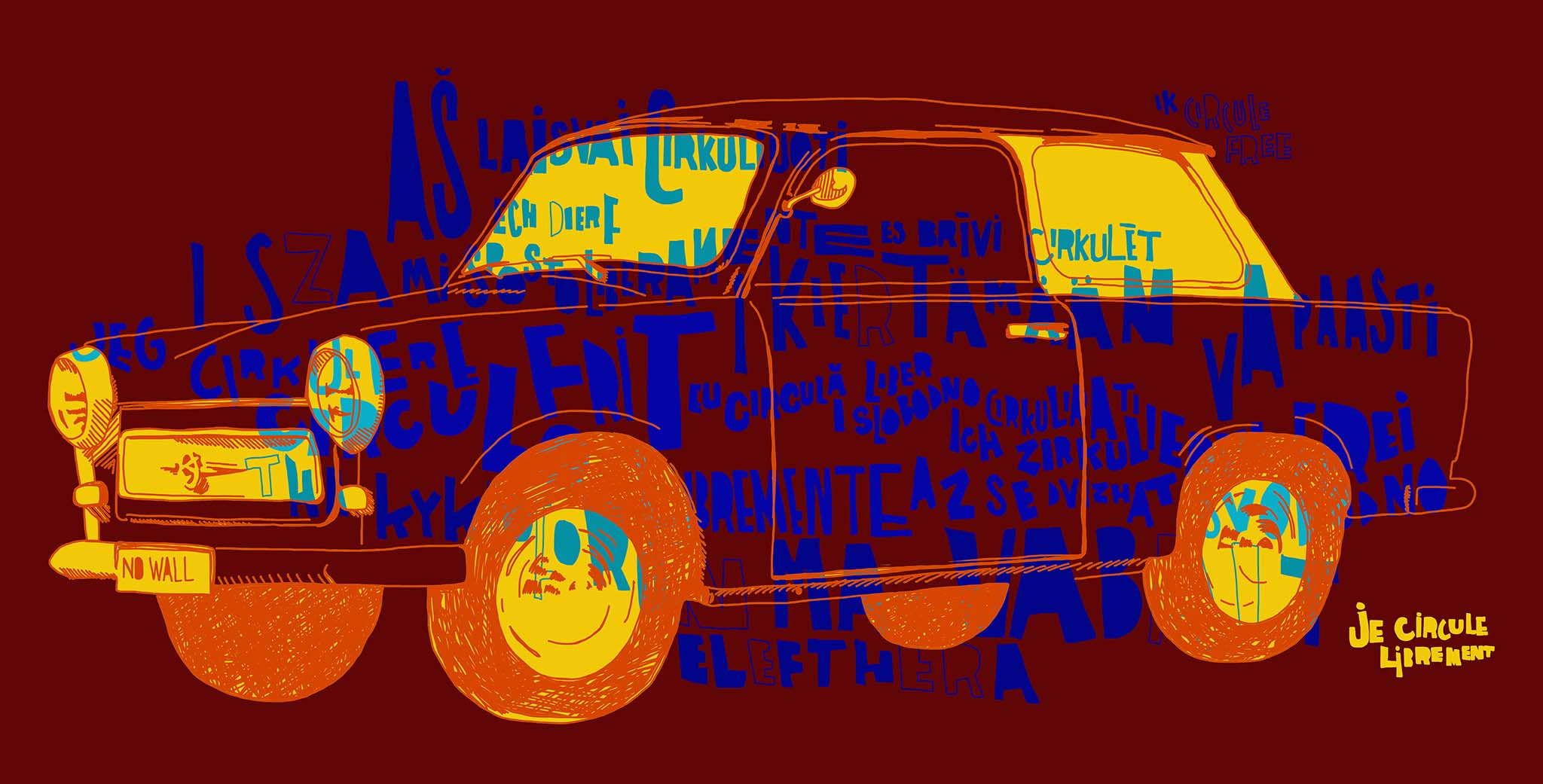
Cela nous paraît évident aujourd’hui, mais cette vieille Trabant nous rappelle que cela n’a pas toujours été le cas. « Je circule librement » a été traduit automatiquement par un logiciel gratuit, ce logiciel fait des fautes. La libre circulation des informations, comme celle des hommes provoque aussi des problèmes de compréhension… parfois. L’identité européenne est une notion en évolution qui se transforme avec sa population, en mouvement.
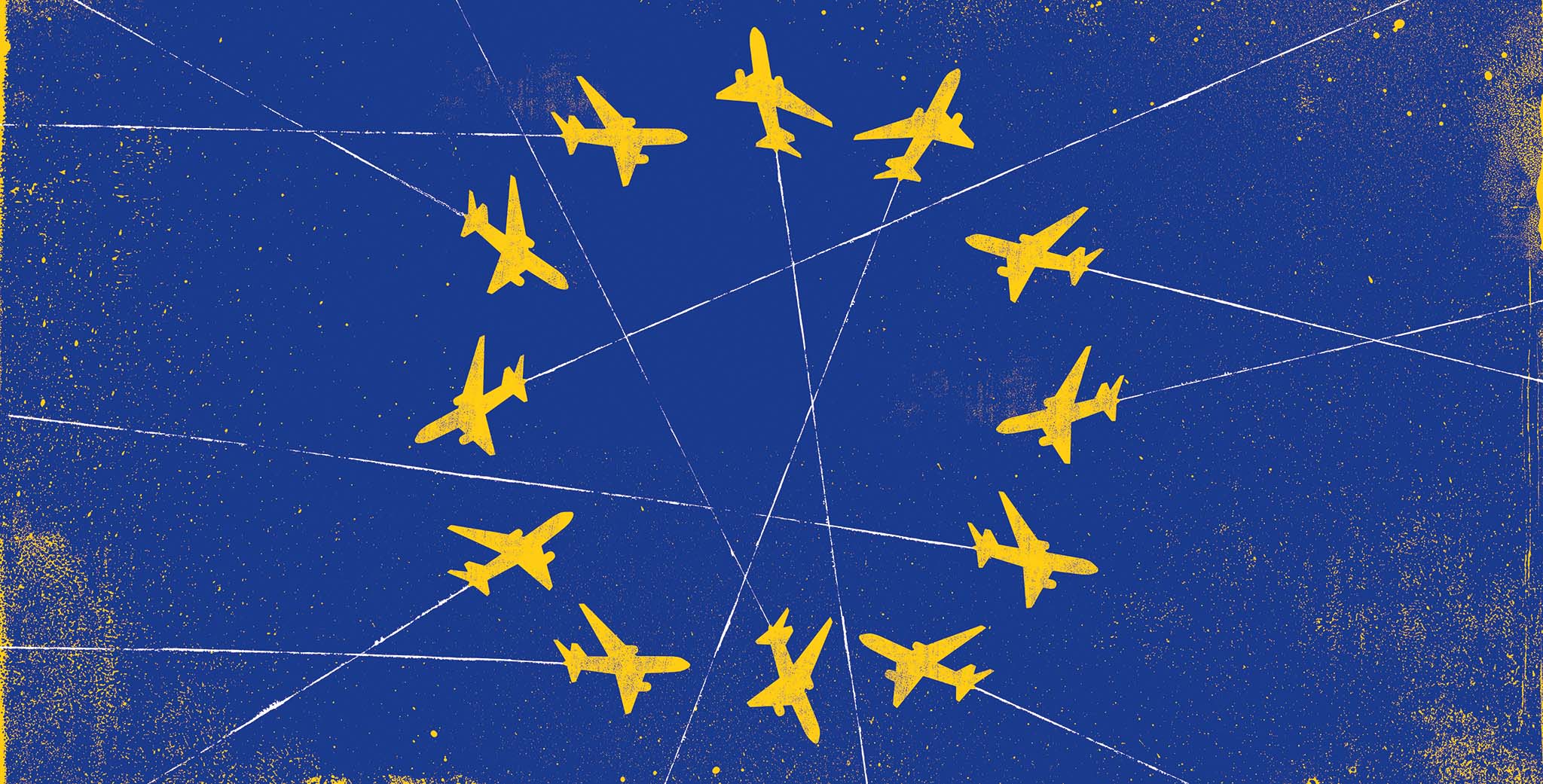
Entre un désir de communauté et des trajectoires singulières, une Europe du partage au coeur des possibles.
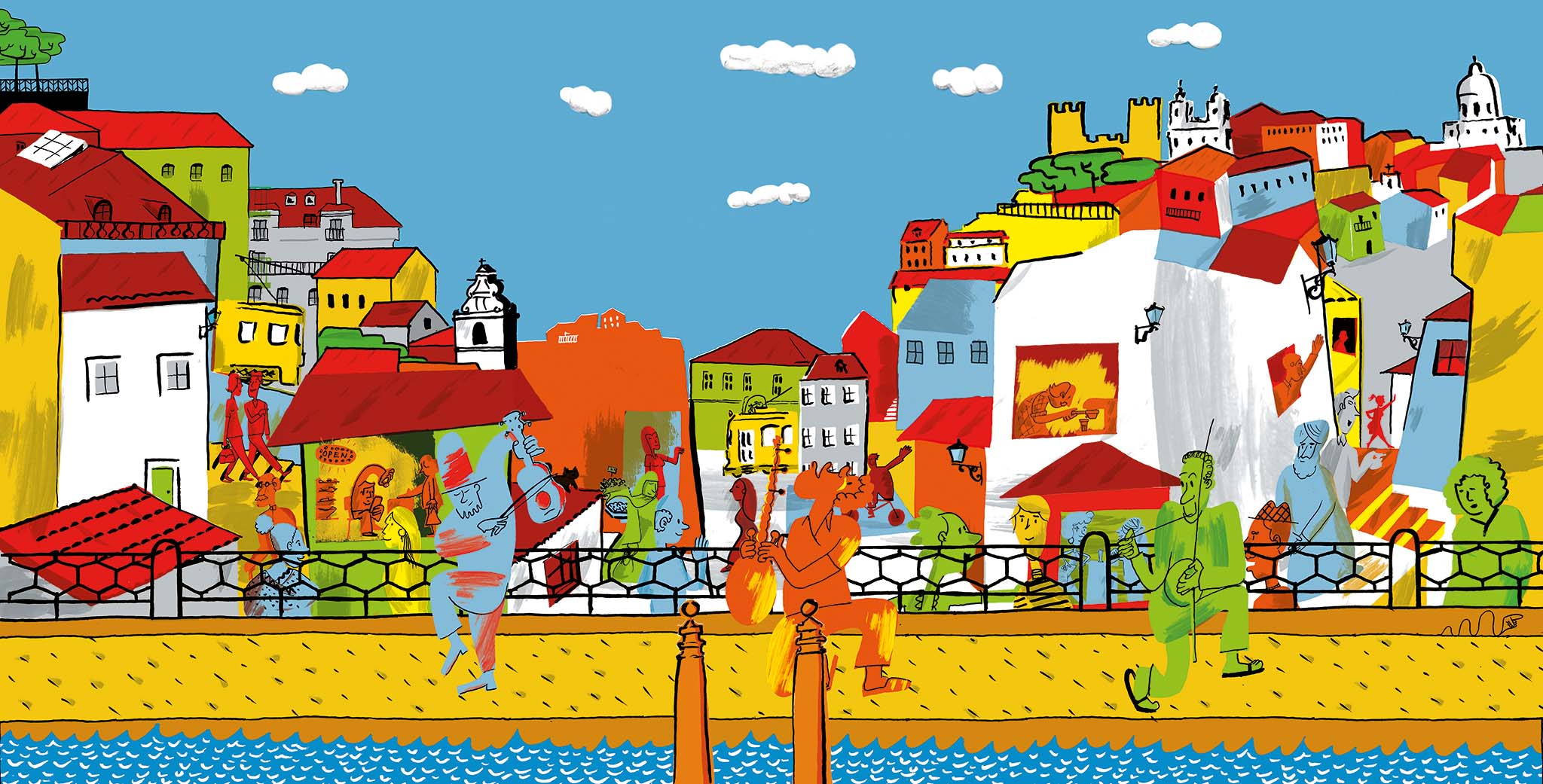
Lisbonne, ma ville, a toujours été un melting pot de cultures, avant même que le pays ait des frontières propres. Un bon nombre de communautés existantes se sont installées il y a des générations. La ville partage une caractéristique avec toutes les capitales d’Europe : une grande diversité d’individus provenant de milieux différents, partageant le même espace, créant de multiples interactions et échanges sociaux qui génèrent de nouvelles dynamiques culturelles. La musique, avec son pouvoir inégalé d’unir et de connecter, est l’une des plus importantes manifestations de cette diversité. C’est un langage universel qui associe une multitude d’éléments et qui peut être exprimée n’importe où, y compris dans les rues, comme signe de joie : la joie de vivre et l’hétérogénéité humaine.

Afin de pouvoir répondre au mieux à la question de l’identité européenne j’ai commencé par me demander d’où le concept d’Europe prenait racine.
Racine. Le mot est resté et l’image m’a plu:
l’arbre représente l’Europe en tant qu’institution dans son rôle protecteur et bienveillant.
ses racines culturelles ou historiques proviennent de toutes parts.
Les fleurs représentent les Européens dans leur diversité et leur variété.
Ils sont différents et poussent sur un même terreau.
La présence de l’arbre leur est mutuellement profitable.
L’Europe est une utopie qui a germé
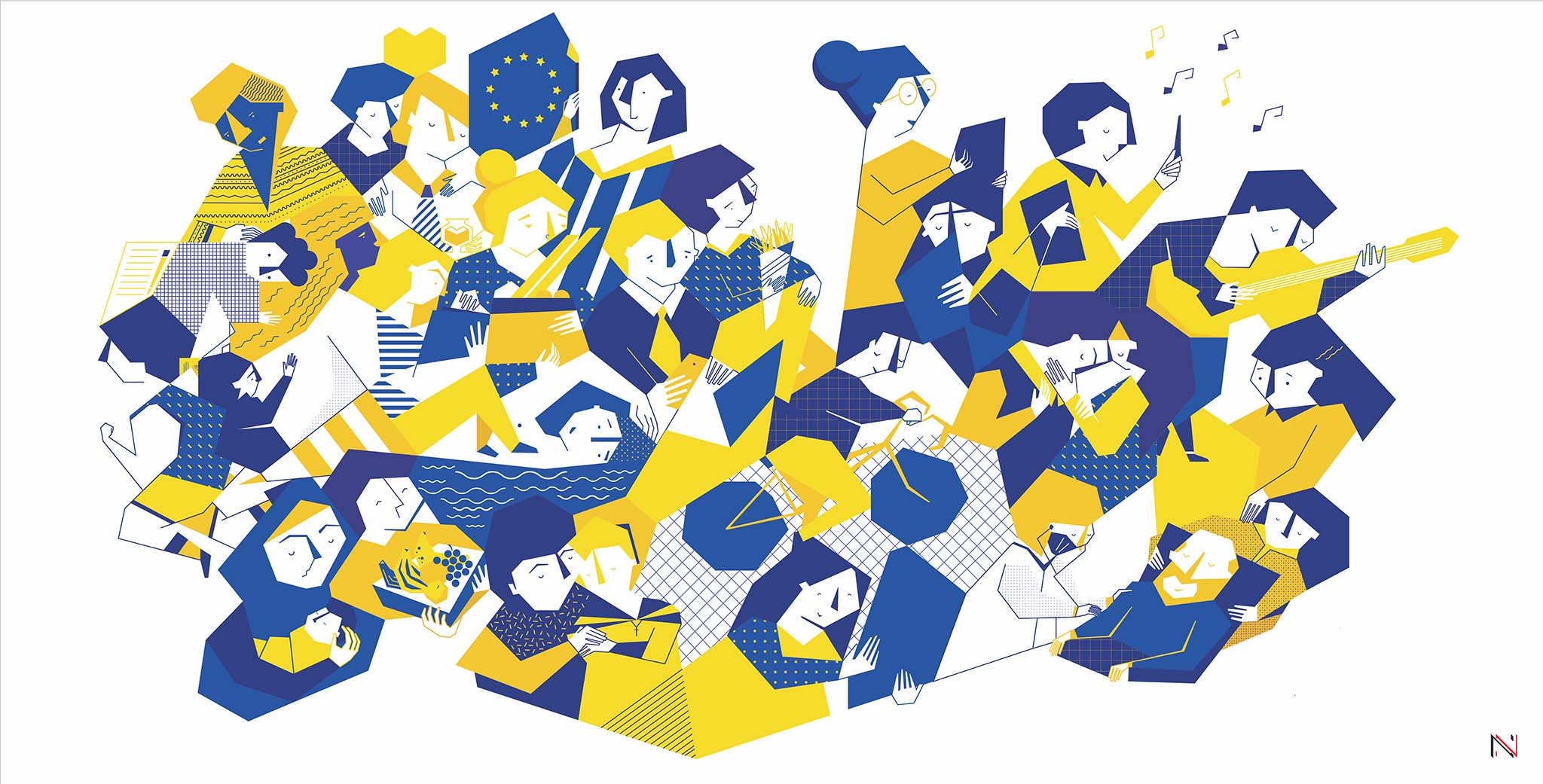
J’aime le fait que, peu importe où je vais, je rencontre des personnes venues du monde entier, de différentes cultures et langues, qui vivent ensemble et partagent leur quotidien. Ce dessin illustre ces différentes nationalités qui se rassemblent pour ne faire qu’une. Pour ma palette de couleurs, j’ai puisé l’inspiration dans le drapeau européen.

Nous trouvons intéressant le fait que certains de nos amis étrangers partagent les mêmes expériences et aventures que nous quand nous étions jeunes. Des vêtements que nous portions à la musique que nous écoutions et la façon dont nous passions notre temps. D’après notre expérience, les frontières européennes sont simplement des frontière formelles. Nous nous sentons vraiment en phase avec nos amis de l’étranger, donc nous avons l’impression de ne faire qu’un.
Nous nous sommes inspirés de cette réflexion pour notre œuvre. Nous voulions montrer que notre apparence, ce à quoi nous ressemblons, est juste un papier d’emballage. Au fond, nous sommes tous pareils. Nous voulons seulement être heureux, aimer et être aimés. Dans notre illustration, nous souhaitions présenter au spectateur deux éléments ; un intérieur et un extérieur évident. Le brun représente la gamme de tons de peau et s’apparente à une peau qu’on retire. Et pour l' »intérieur », nous avons choisi un bleu clair et optimiste, représentant le paradis et la tolérance.
Après tout, ne sommes-nous pas tous faits d’eau ?

J’ai décidé d’illustrer un long tandem pour exprimer l’idée d’une union entre les pays, en gardant l’identité de chaque membre à travers les costumes traditionnels.
joanalturo.com
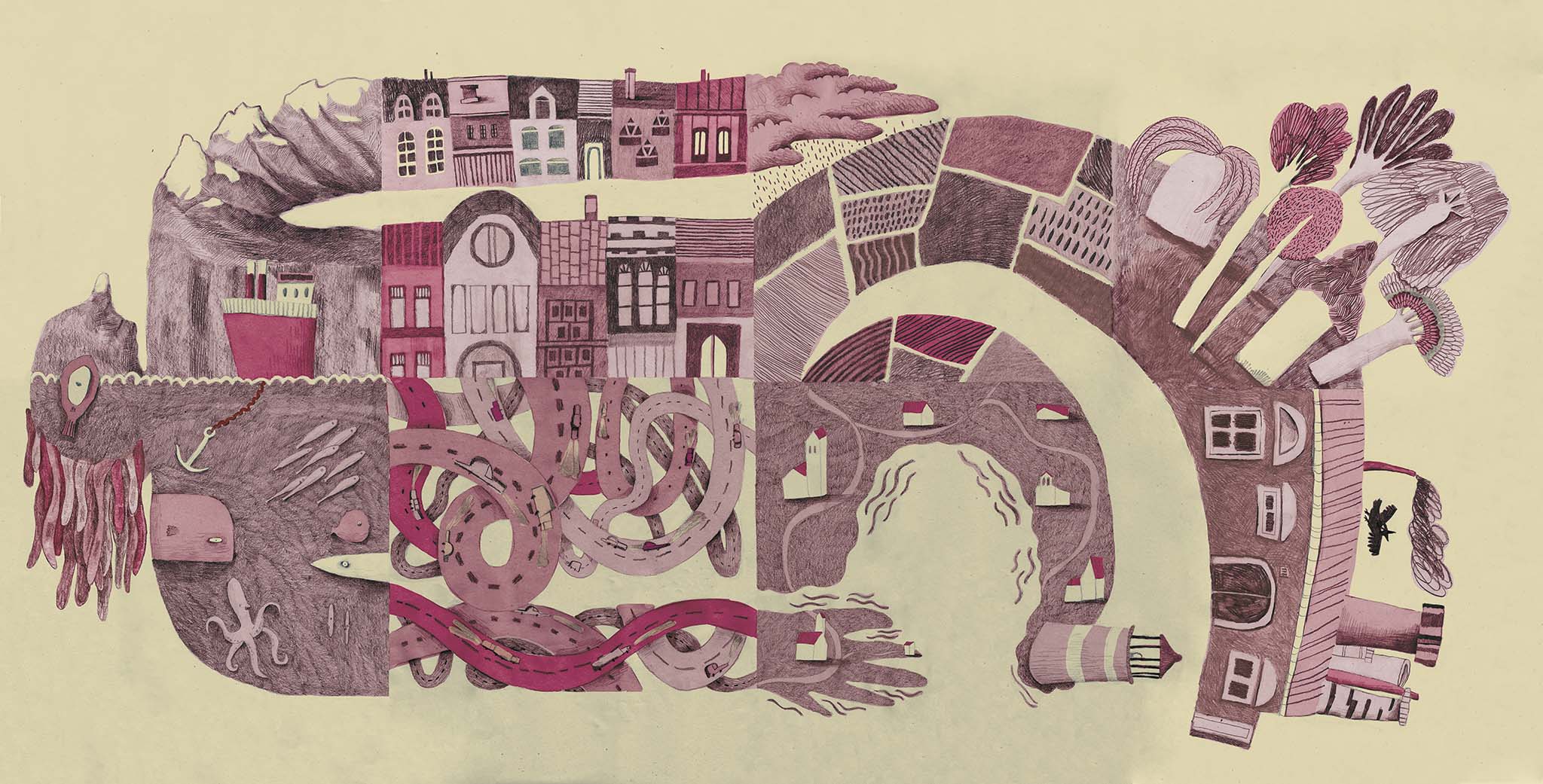
Plusieurs lieux composent le corps d’une femme, Europe. Chacun des lieux est indispensable aux autres pour qu’elle s’articule correctement. Elle respire, se meut et évolue. Elle évolue à chaque pas.
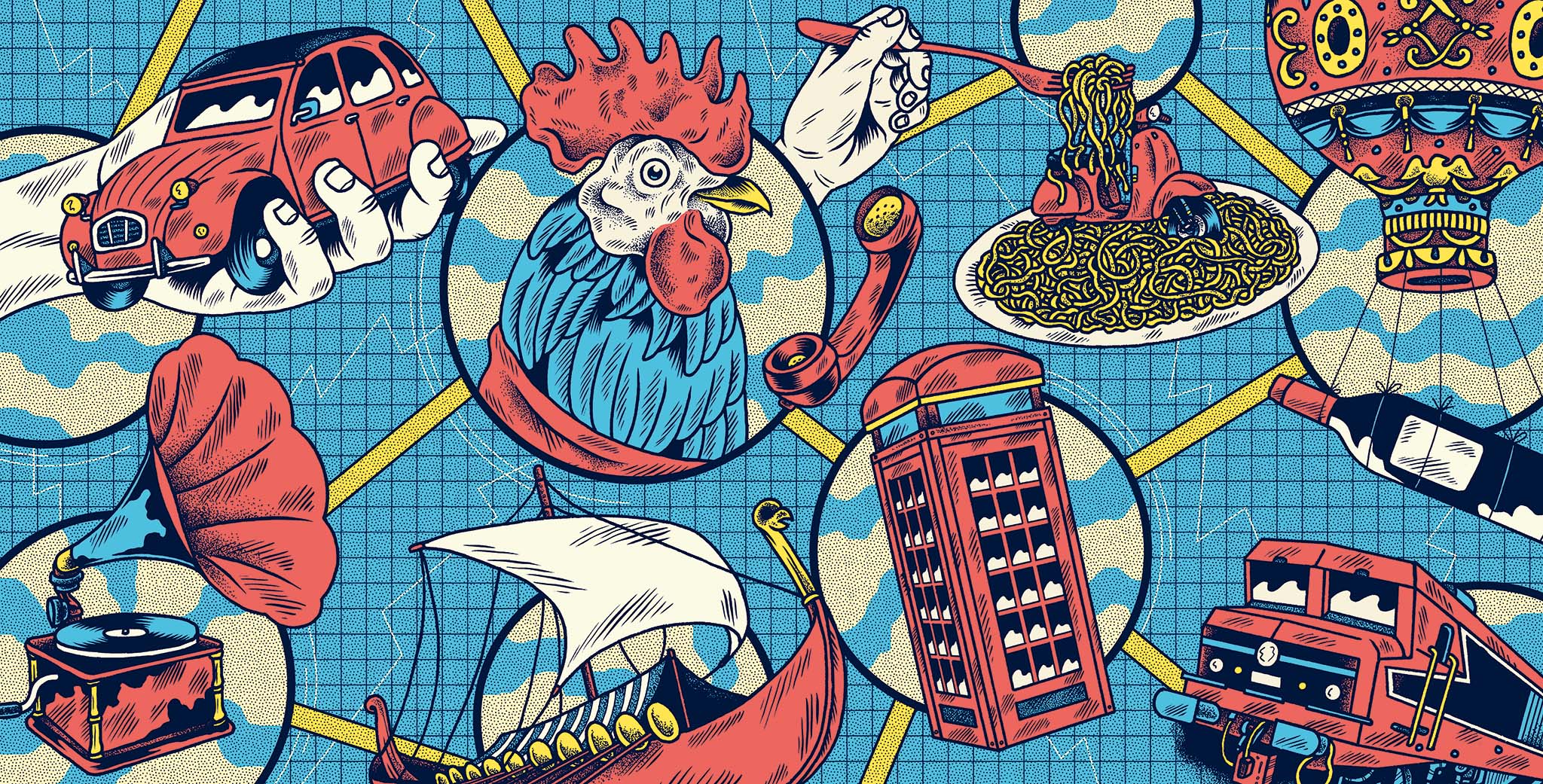
La réflexion sur l’identité Européenne me renvoie à mon enfance, au début des années 90, quand habitant Metz et étant voisin de pays comme la Belgique, le Luxembourg ou l’Allemagne, chaque séjour dans l’un de ces pays ressemblait à une épopée avec son mélange d’excitation et de crainte, sentiments extrêmes et infondés propres au jeune âge. Aujourd’hui, c’est avec plus d’aisance et de certitude que je peux circuler librement en Europe, partagé entre la nostalgie d’une image et d’un sentiment disparus, et la satisfaction de pouvoir rencontrer l’inconnu dans des terres qui me semblent pourtant familières et amicales.

L’identité européenne est une volonté de vivre ensemble, de partager sa culture, de coopérer… Et tout ça dans la bonne humeur.
Quoi de mieux qu’un bon repas pour évoquer tout ça ?

Le titre de mon œuvre est « Personnel et cessible ». Elle représente l’idée de recevoir et de donner l’identité européenne à tous ceux qui embrasse l’Europe.
tiagogalo.com
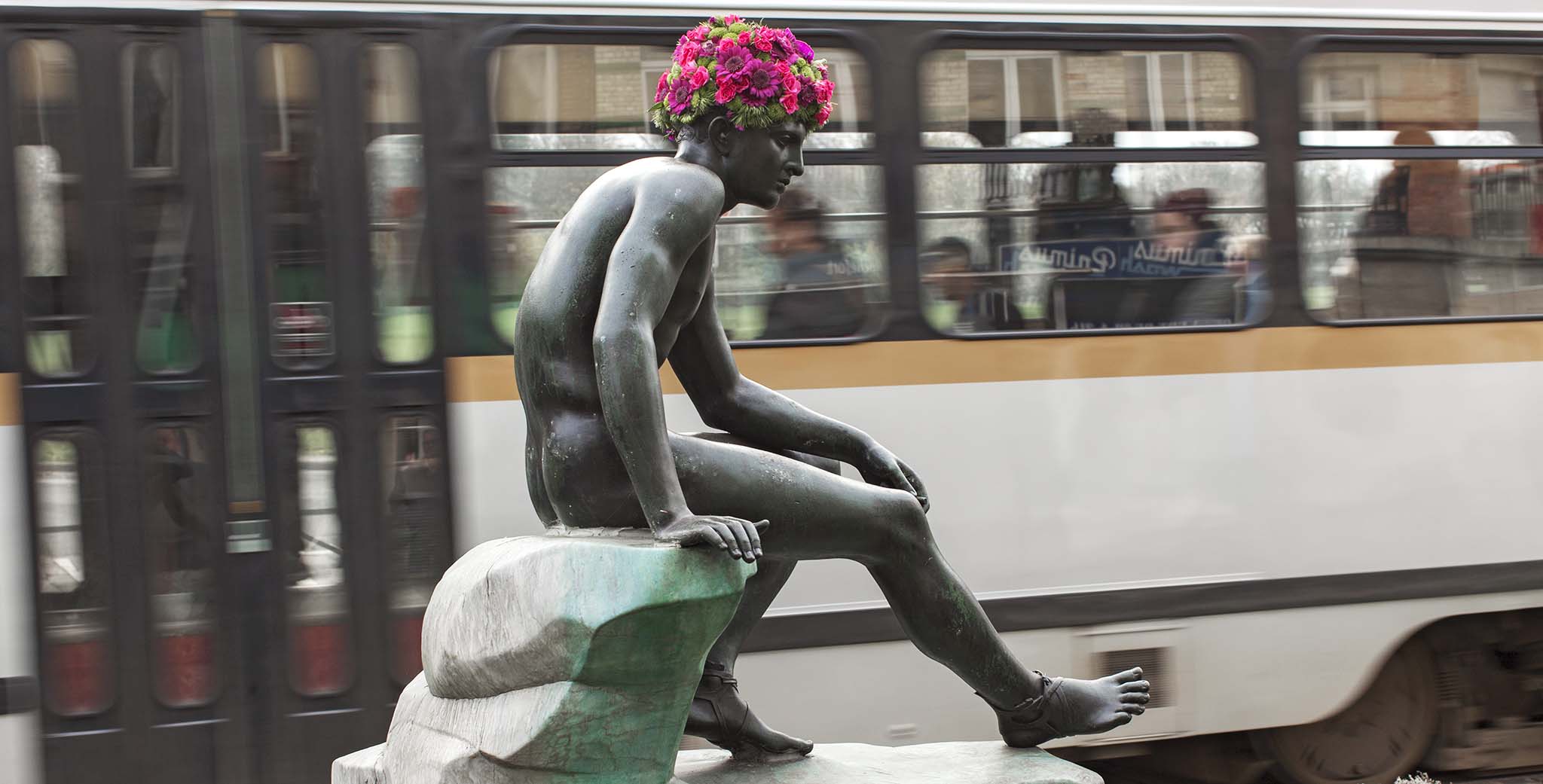
Mon travail est très européen, je mets la lumière sur les oeuvres qui parsèment nos villes, en mettant en avant très souvent des personnages qui ont une forte identité européenne, les sculpteurs ont très souvent voyagé à Paris, en Italie, ou d’autres villes européennes pour affiner leurs techniques.

European Identity Flag
L’illustration représente le drapeau européen avec une belle métaphore visuelle : douze nageuses synchronisées nageant dans une eau bleue, le même bleu utilisé pour le drapeau européen. Chacune des nageuses a une étoile à la cheville et ses propres détails, culture et drapeau, symbolisant les différents pays d’Europe. L’illustration reflète l’identité européenne multiculturelle toujours présente de chaque pays. Et telle un groupe de nageuses synchronisées, la relation entre les pays est respectueuse et cordiale, agissant toujours dans un but commun.

Illustration tirée du livre « Il existe des classes sociales » (Media Vaca 2015).
Contrairement à l’idée d’un noyau de puissants insistant sur l’idée d’uniformité, nous savons tous que la diversité est la richesse et le pouvoir d’améliorer le monde pour qu’il soit meilleur pour tous.
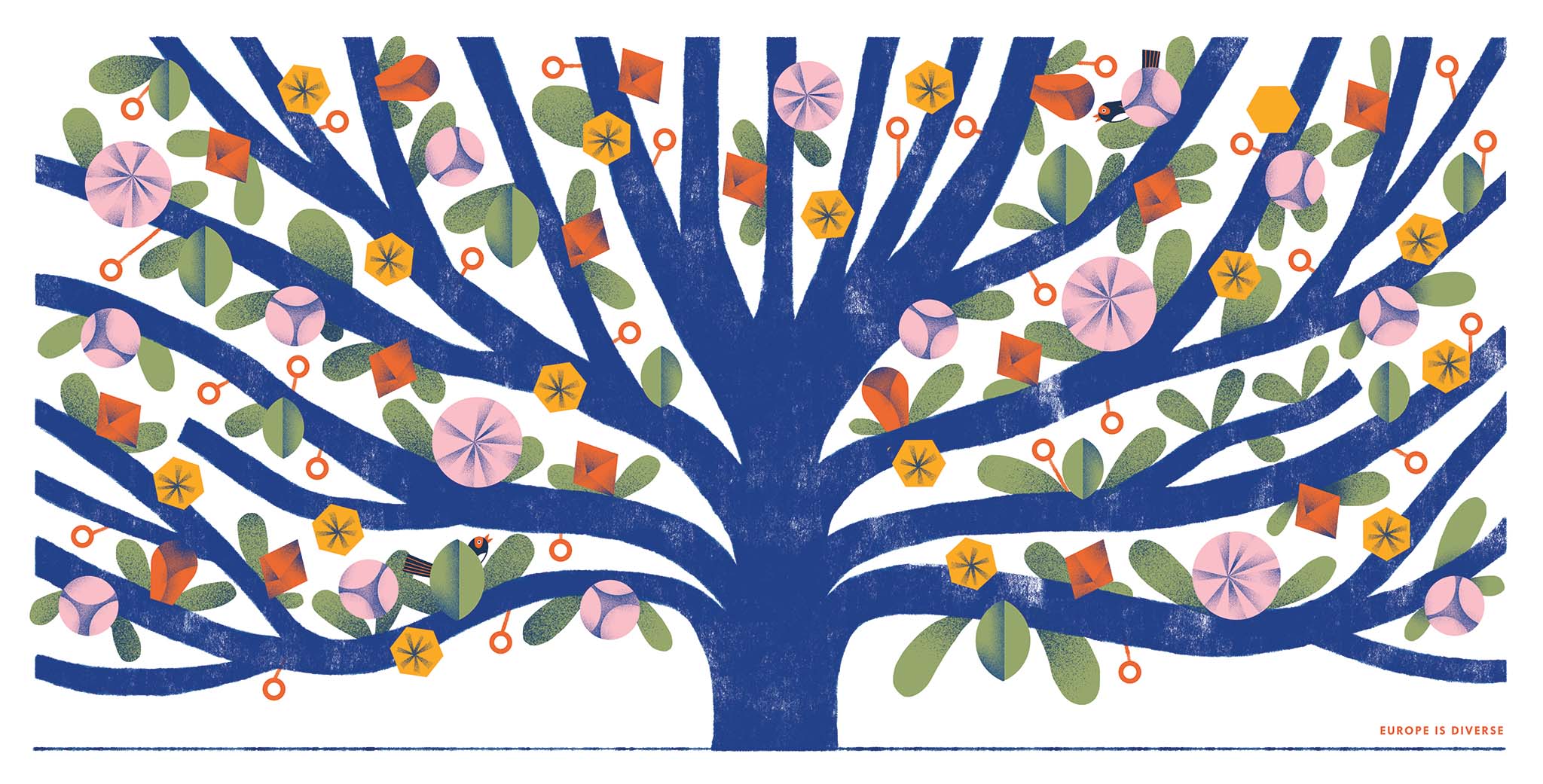
L’Europe est diverse. L’Europe, c’est une grande variété de cultures qui forment une entité unique. Comme dans cet arbre qui la symbolise où chaque fleur est différente et belle.
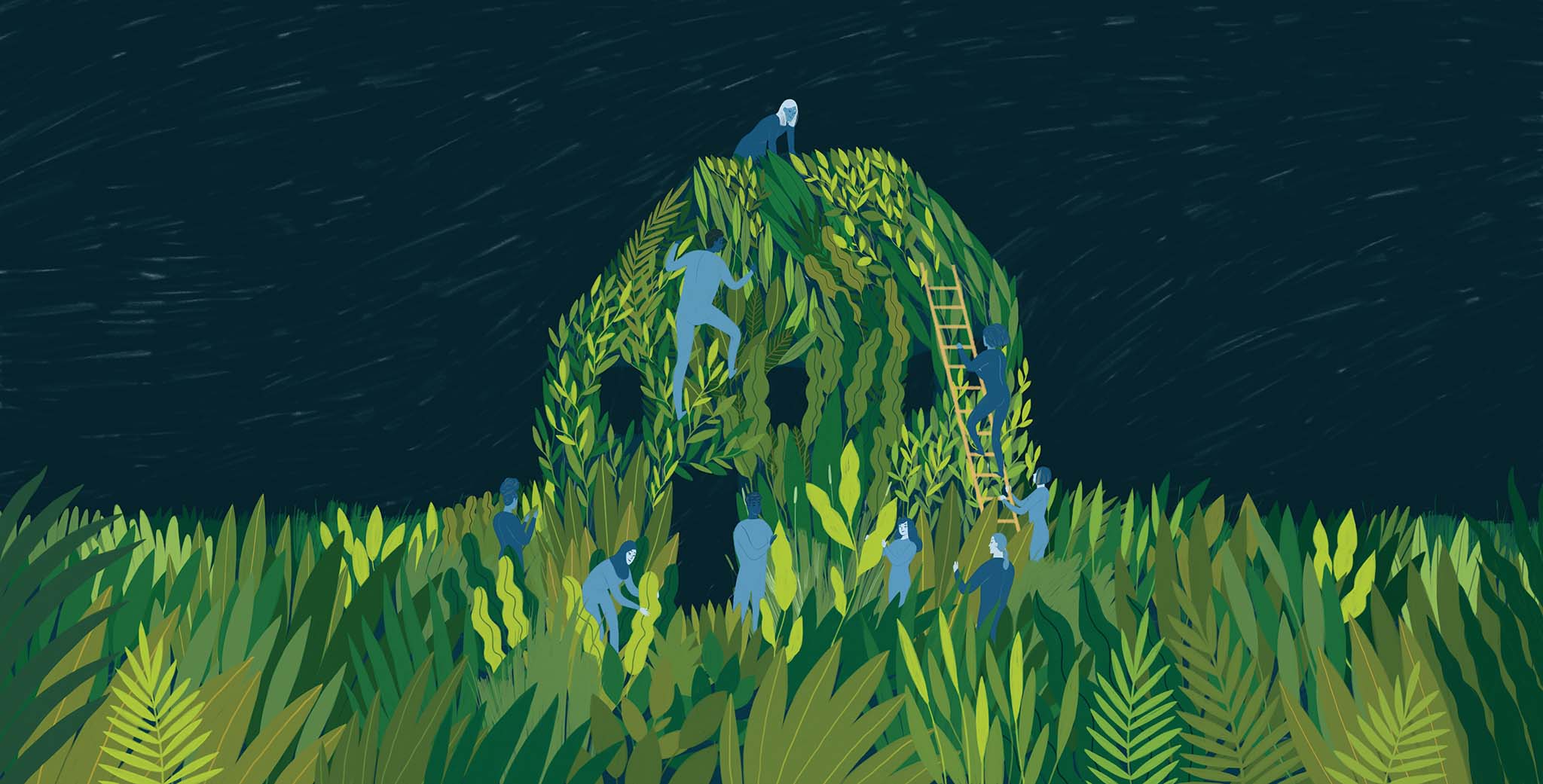
Je crois que l’Europe devrait célébrer les différences et construire ensemble, c’est pourquoi j’ai choisi de faire une maison faite de plantes que différents individus construisent et entretiennent collectivement. La société est quelque chose qui se développe naturellement selon différents « points de vies », comme pour cette maison ; les plantes sont par nature fragiles, mais grâce au dévouement et aux soins adéquats, elles peuvent devenir fortes et résistantes.

Mon illustration fait apparaître ma double culture de Colombien et Portugais, à travers la représentation de mes grands-parents et d’un nouveau-né (moi). Le bébé est au centre, entre deux personnes qui possèdent déjà une identité propre de paysan. Le bébé est un personnage neutre qui n’a pas encore de représentation culturelle, mais sa culture va naître d’un mélange de quelque chose qui existe déjà.
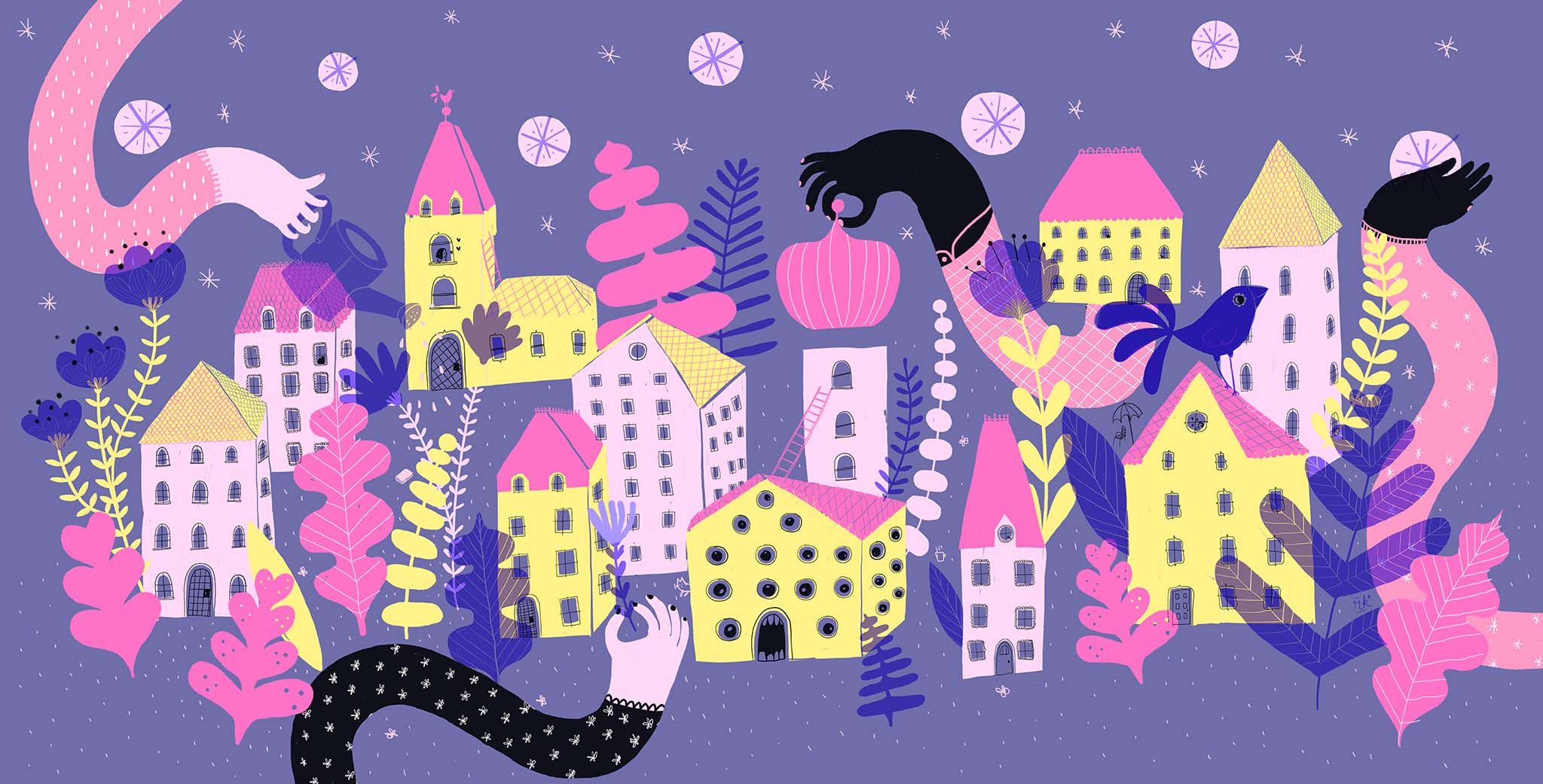
Voici ma principale idée pour cette illustration : j’ai imaginé chaque individu comme le créateur d’un avenir commun, tout le monde apporte quelque chose de bon et de nouveau dans la réalisation d’un objectif commun. Par exemple, il y a les gens qui ont un fort sens de la communauté et n’ont aucun problème à accueillir chaleureusement n’importe qui ; il y a ceux qui ont la main verte, doués pour faire pousser et grandir les choses ; et encore ceux qui apportent la lumière et font briller un endroit simplement par leur présence.

Pour moi l’Europe est comme une couverture en patchwork. Elle est constituée de nombreuses couleurs et pièces différentes et évoque le confort douillet et la sécurité. Je peux m’enrouler dedans, apprécier la chaleur et le sens de l’interdépendance et du voisinage.
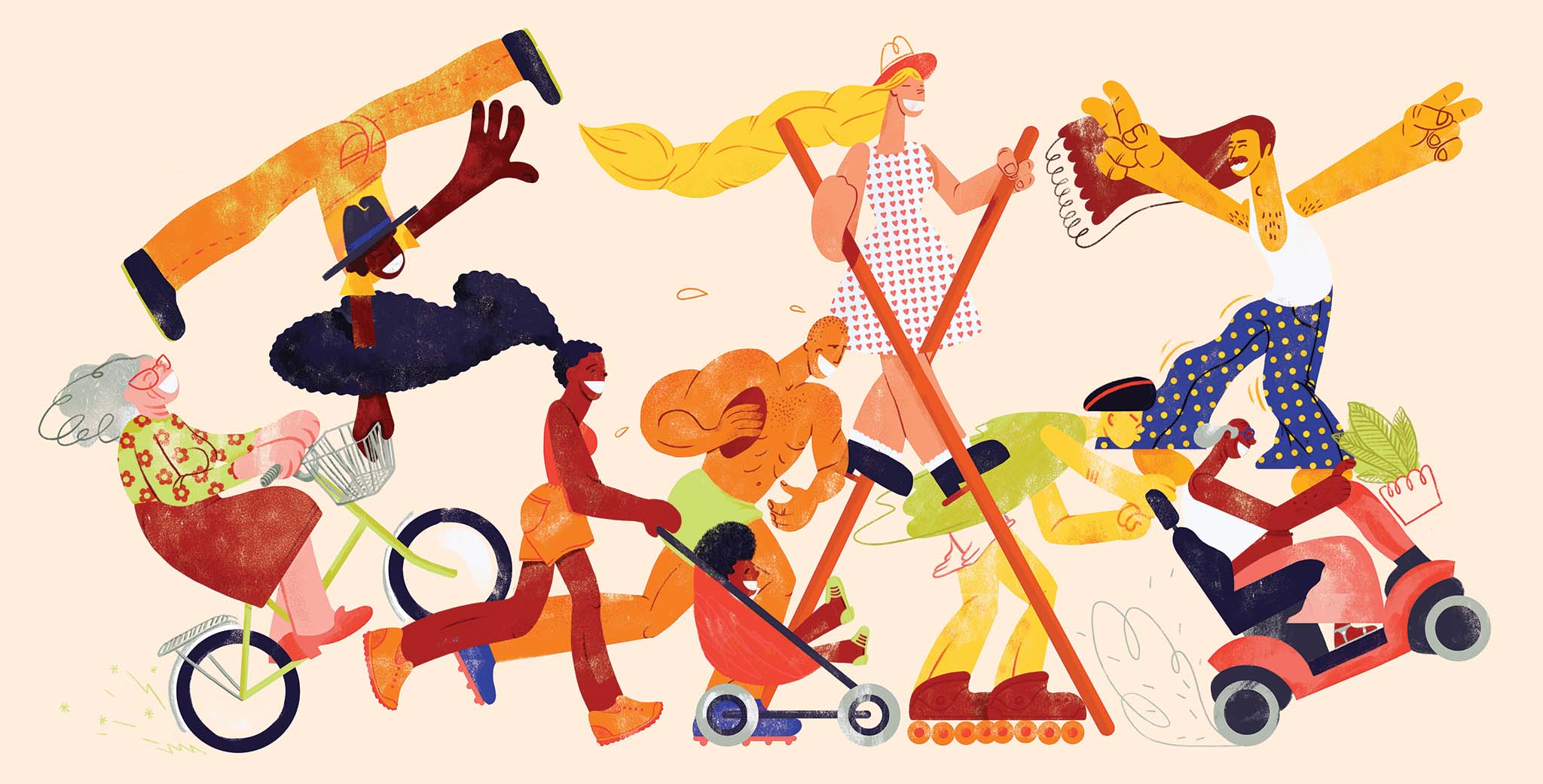
J’ai choisi d’illustrer un mouvement avec des personnages funky pratiquant des activités en plein air qui rapprochent les uns les autres les individus de différentes cultures, âges et genres !
behance.net/maradrozdova
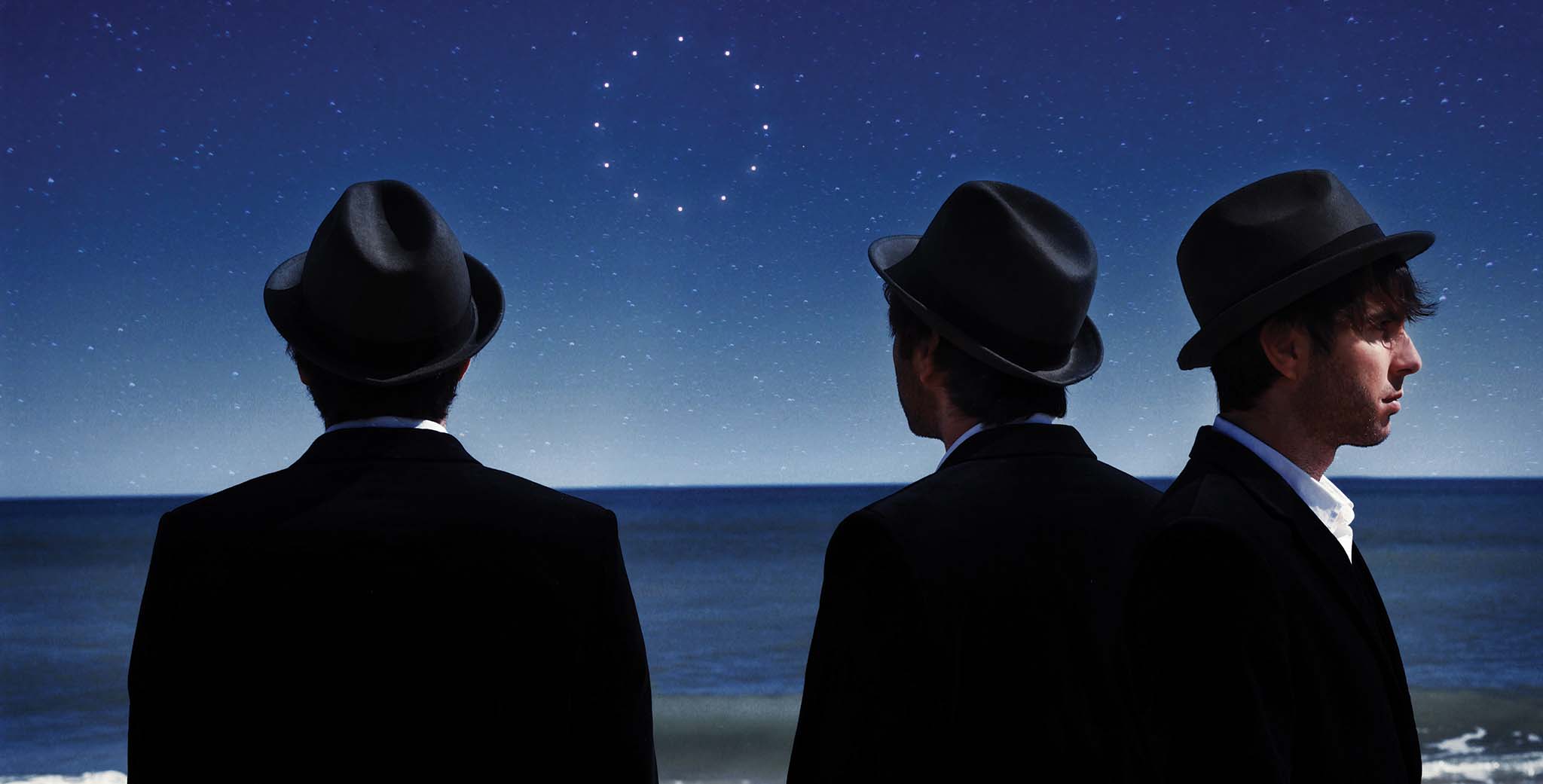
“Sosies”
L’idée d’identité multiple d’un seul individu. En questionnant ma propre identité, je me suis vu comme un ensemble d’êtres multiples (des sosies), dans une lutte perpétuelle pour éviter mon individualité et mon caractère unique. Ce pourrait être une métaphore sur l’identité européenne, d’un point de vue individuel.
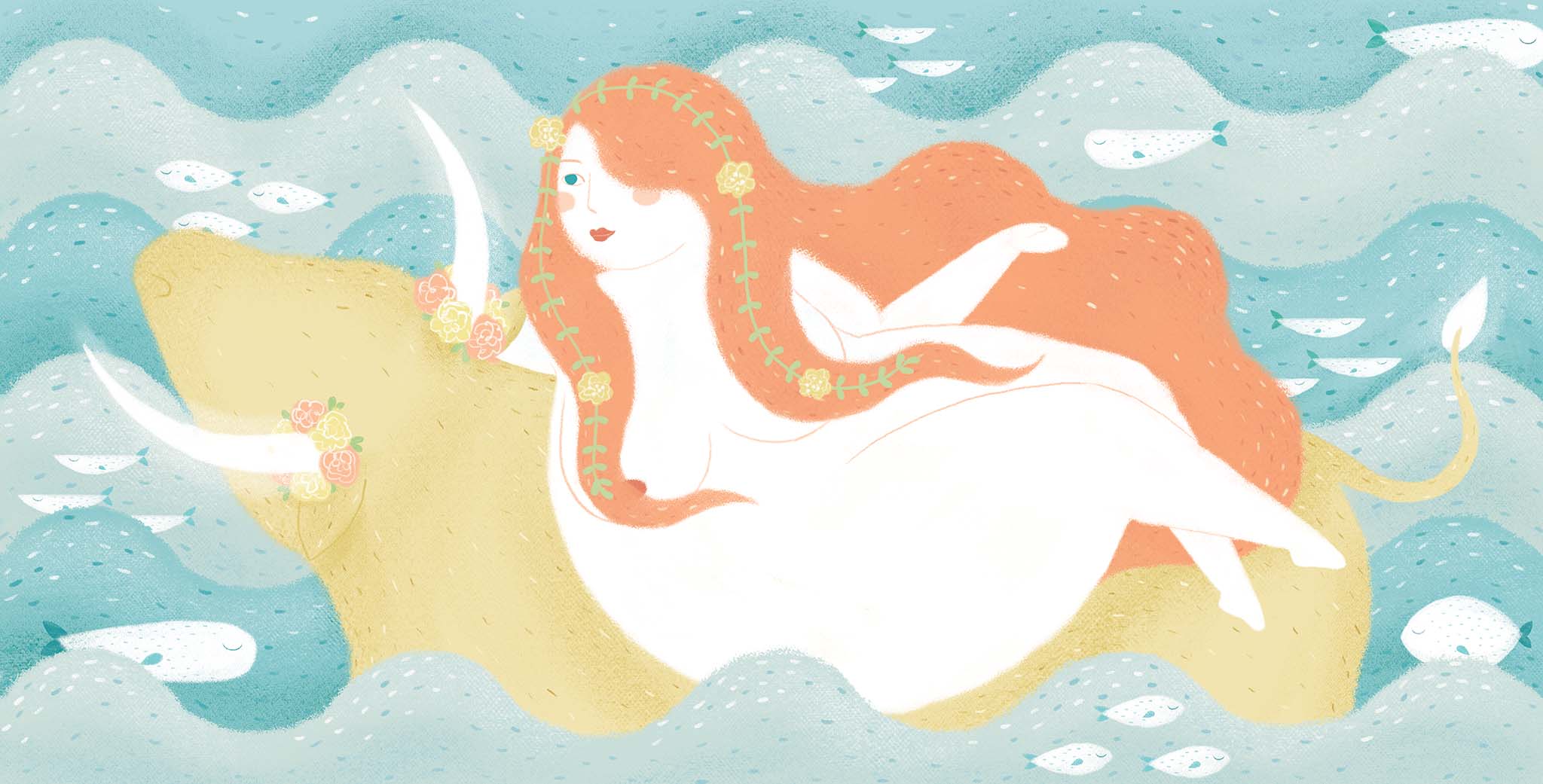
“Europa et le taureau”
Cette illustration est inspirée du mythe grec d’Europa pour rappeler l’origine lointaine que nous avons tous en commun en tant qu’européens et malgré nos différences.
susannaalberti.com
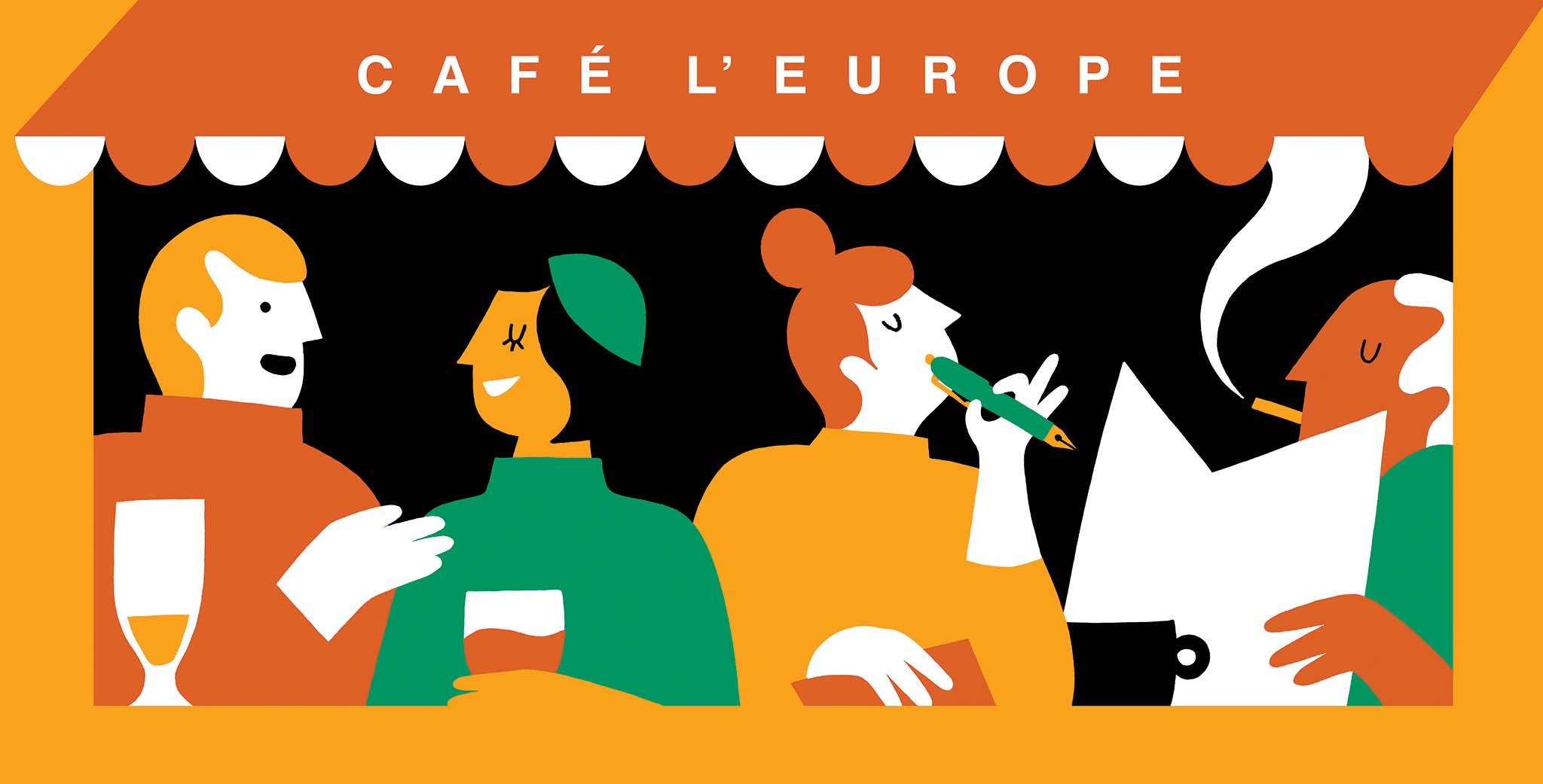
Café l’Europe
Les cafés sont très représentatifs de l’Europe. Depuis le 17e siècle, c’est le lieu de rendez-vous de prédilection des intellectuels, écrivains, poètes mais aussi des gens du peuple. C’est un lieu pour faire des commérages, pour parler de démocratie, écrire des romans ou lire les journaux.
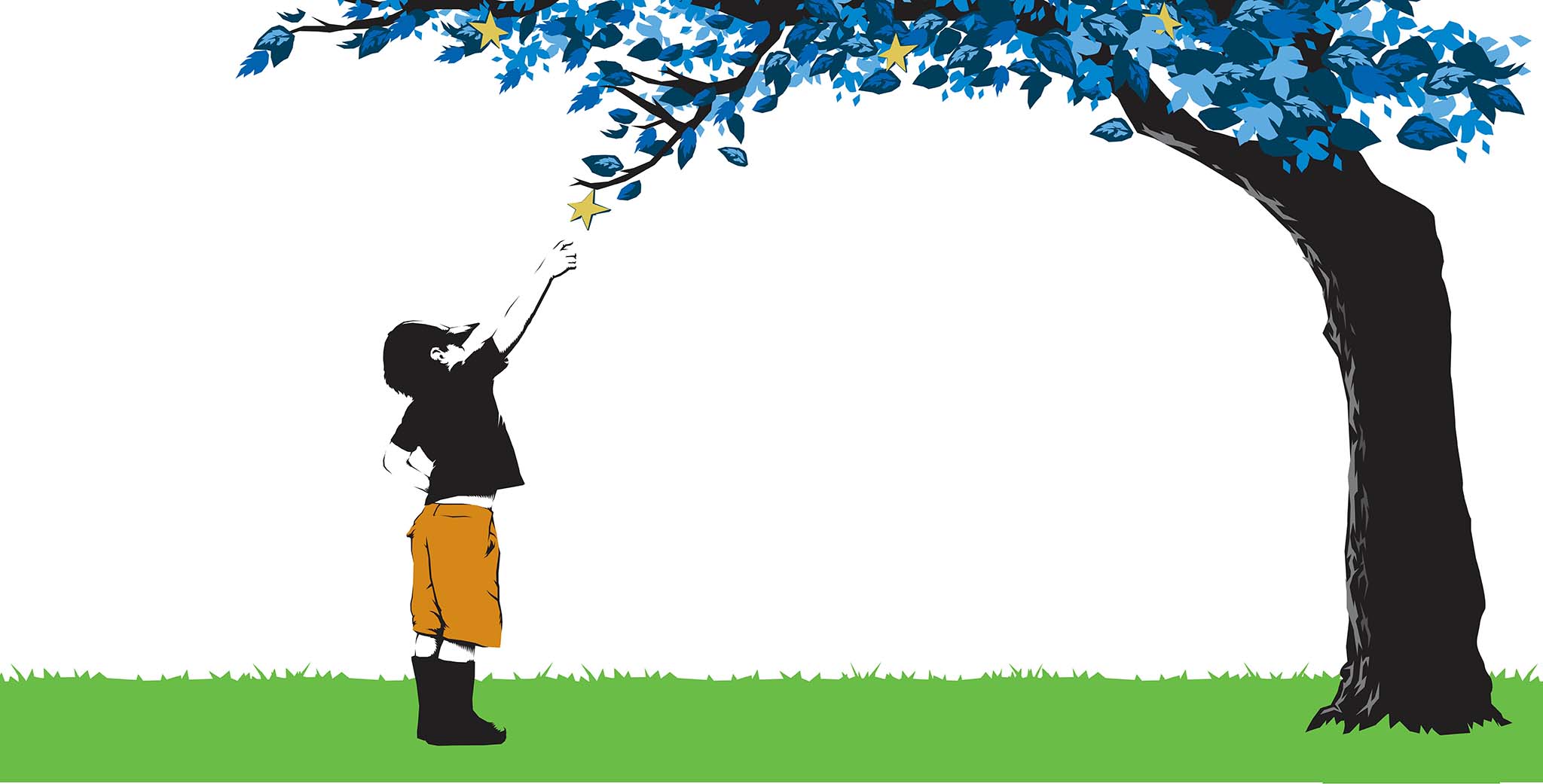
Ce visuel représente le futur de l’Europe, la jeunesse qui se nourrit des connaissances et du savoir d’un même arbre. Cet arbre représente la vie, les branches de l’arbre représentent les diverses cultures et pays de l’Europe.

J’ai apprécié travailler sur ce projet parce que je me sens vraiment plus Européenne qu’Italienne. Après avoir vécu trois ans à Londres, en contact avec des gens de toutes les parties du monde, j’en suis venue à croire que la façon de construire une identité européenne n’est pas seulement une histoire de voyage, mais surtout d’échanges d’expériences et de rencontres avec d’autres voyageurs venus d’autres pays d’Europe.
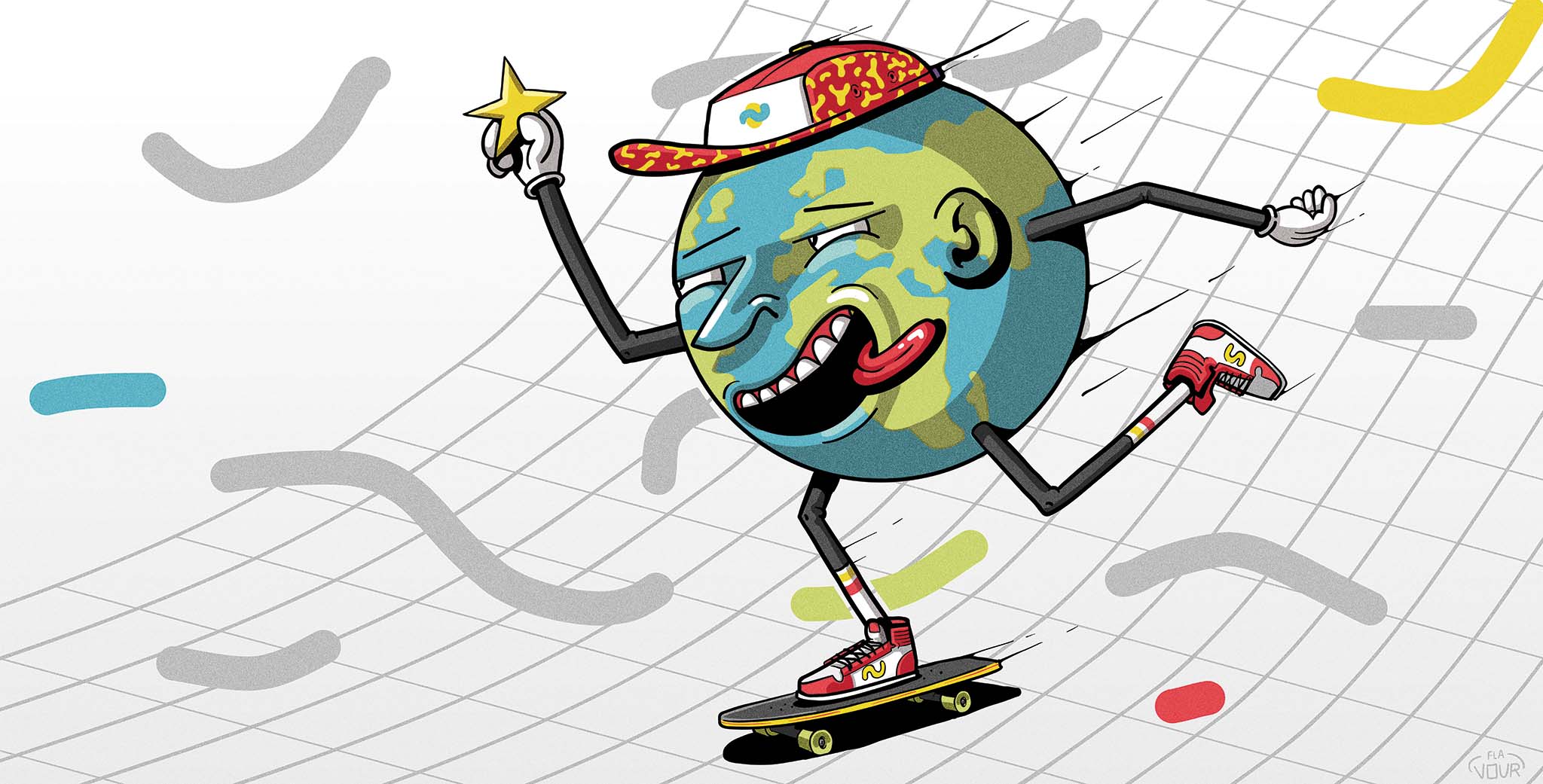
Comme nous pouvons le constater, l’Europe a un rôle primordial dans la croissance mondiale. C’est un processus fluide comme chevaucher un skate dans une descente. Je vois l’identité européenne comme très forte, un lien loyal qui nous mène vers le progrès mondial sous tous ses aspects.
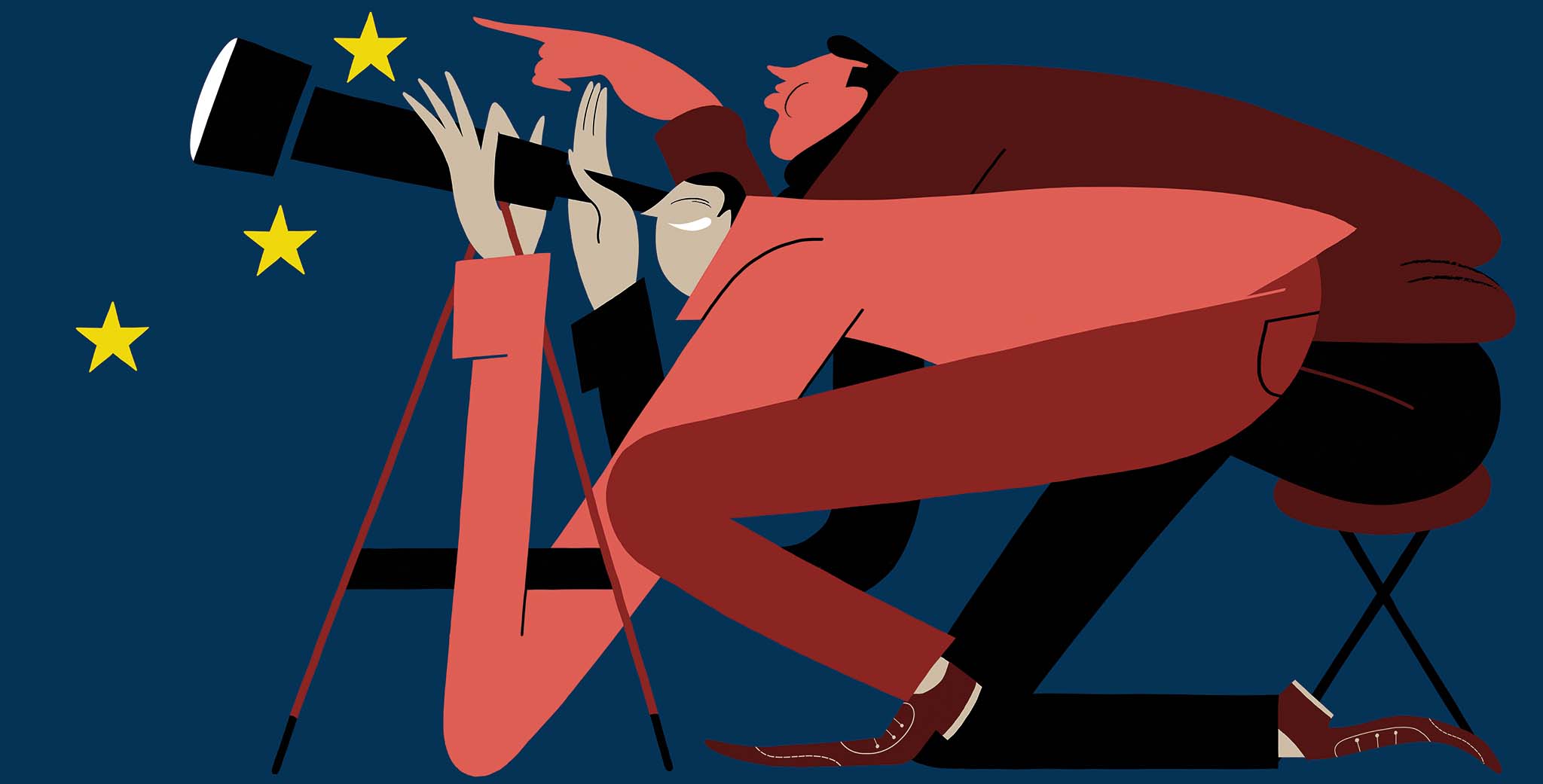
Je pense que l’Europe est toujours à la recherche de solutions pour le futur, d’une situation parfaite pour le monde.
Peut-être que c’est une utopie mais au moins nous essayons. Je pense que le télescope pourrait être un bon symbole pour cela.
Découvrez de nouvelles choses, apprenez, cherchez un meilleur endroit, etc. Bien sûr, c’est un clin d’œil au drapeau de l’UE.
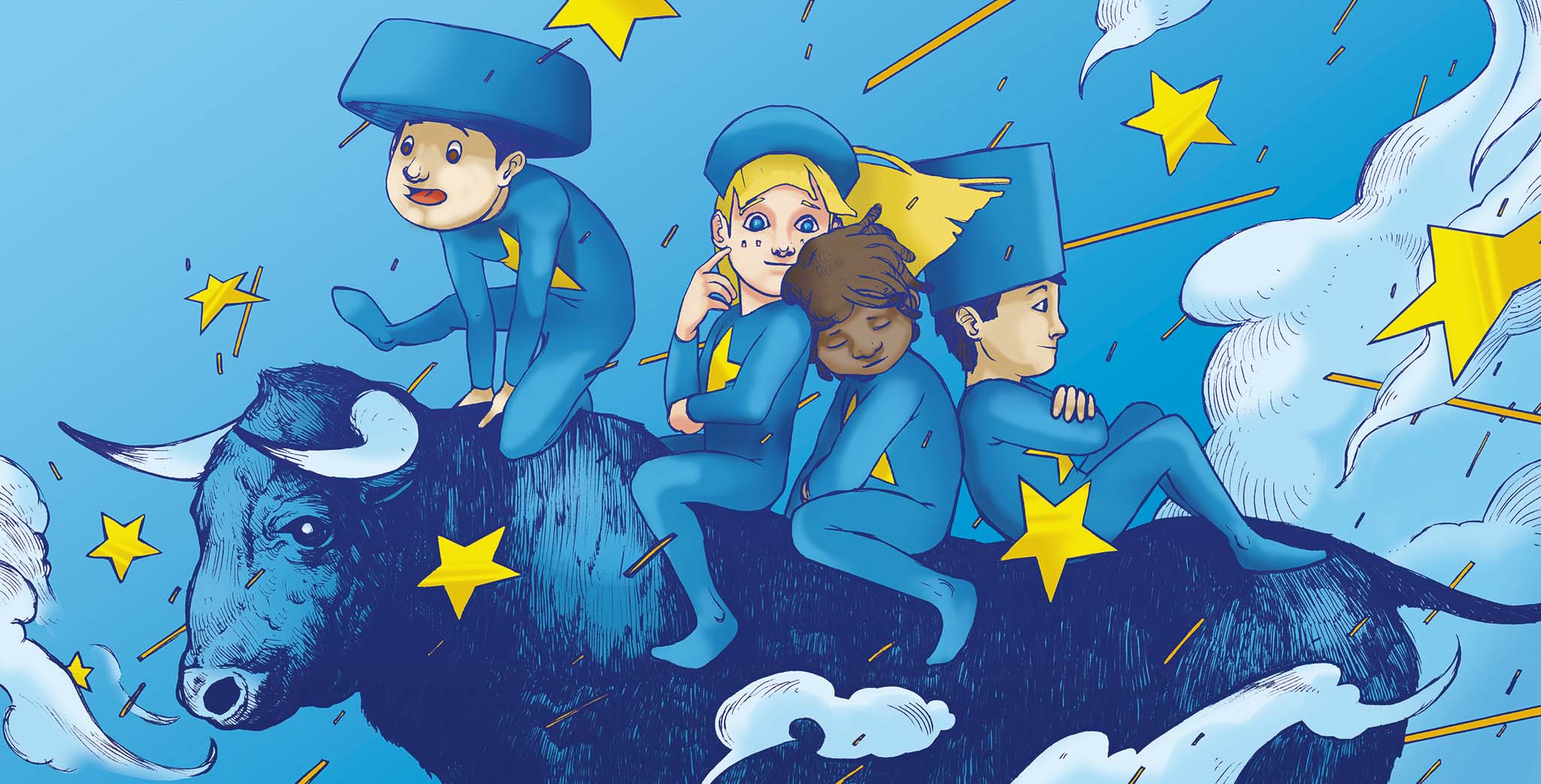
Tout a commencé lorsque Zeus a adopté la forme d’un gros taureau. Aujourd’hui, la responsabilité de l’avenir de l’Europe incombe à la première génération qui est née avec elle et j’en fais partie. C’est un grand défi pour l’avenir, pour lequel nous devons tous être unis.

Pour ce projet, j’ai décidé de m’inspirer de personnages de théâtre portant des costumes de l’Âge d’or, car le théâtre et la littérature sont vraiment enracinés dans notre culture et font partie de notre identité. Ils relatent des histoires différentes de la vie quotidienne, des faits ou des événements importants de notre histoire et perpétuent nos traditions.
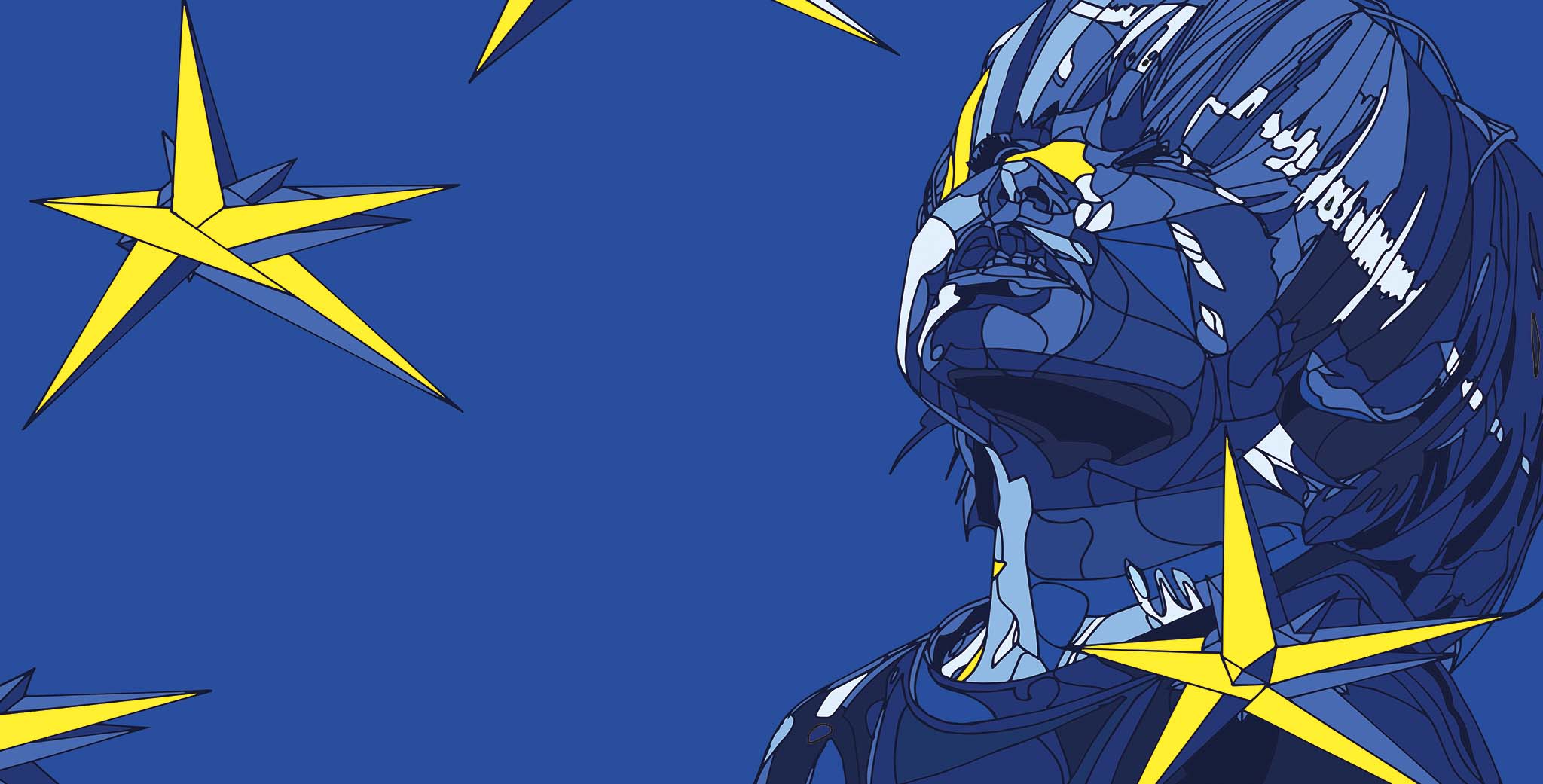
À l’instar de la statue de la Liberté symbolisant la Liberté éclairant le monde, l’enfant européen contemple les étoiles jaunes qui représentent son avenir au sein de l’Europe avec ses valeurs de solidarité, d’union entre les peuples, de démocratie et de paix. Les étoiles d’or se reflètent sur le visage de l’enfant et l’illuminent, lui garantissant un avenir radieux.

Le métissage génère une richesse culturelle, et la solidarité est l’axe fondamental d’une Europe jumelée, juste et diversifiée.
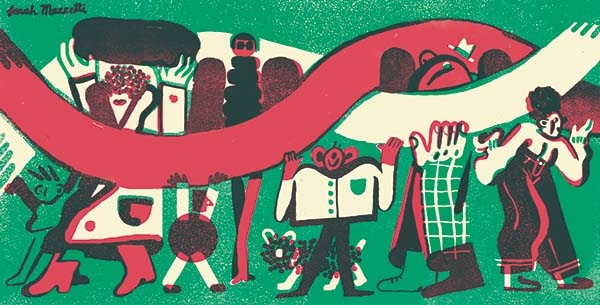
Différentes personnes de différentes nationalités, genres et âges tiennent un chromosome – il ne faut pas imaginer un chromosome au sens littéral, il s’agit là d’une forme reconnaissable mais plutôt abstraite.
MIXITY EUROPEANNESS
‘Ben ik Europeaan’? 60 kunstenaars. 60 antwoorden
60 kunstenaars uit de volledige Europese Unie gaan binnenkort via evenveel creaties op zoek naar een antwoord op wat de Europese identiteit nu juist inhoudt. De kunstwerken die dit opleverde werden afgedrukt op werfdoeken die in de Europese buurt in Brussel voor verschillende bouwwerven zullen worden geplaatst.
Lees het persbericht





Gezichten, silhouetten, handen, woorden en uitdrukkingen vormen een visie op Europa, dat complex is omwille van zijn verscheidenheid. Een culturele smeltkroes van de mensen die het oude continent vandaag bevolken, met elkaar vermengd in een vibrerende flow die de sleutelwoorden van het project bijna onleesbaar maken.

Mijn foto werd genomen in Molenbeek in het kader van mijn project, dat jongeren en opvoeding in beeld wil brengen.
Hij werd gemaakt tijdens een carnavalsfeest en doet volgens mij denken aan de sterren van de Europese vlag, aan de vreugde om samen te leven en plezier te maken, zonder belang te hechten aan onze afkomst. Ik heb mijn project in het leven geroepen om in de tegenaanval te gaan tegen de media die de gemeente Molenbeek door het slijk haalden. Ik besloot foto’s te maken van mensen die strijden om de dingen te veranderen. Het dagelijkse leven van mensen die in een sociaal kwetsbare wijk wonen.

Het werk is ontstaan vanuit het idee van de taalkundige identiteiten van Europese talen. In de meeste talen gebruiken ze hetzelfde woord voor het spelen van muziek en het spelen van een spel. In mijn taal heeft het werkwoord spelen betrekking op het spelen van een spel en op dansen, wat ook weer verband houdt met muziek. Muziek, dansen, spelletjes, gezamenlijke activiteiten, iedereen houdt zich daarmee bezig en ervaart ze als positief.

Het werk heeft tot doel om de verschillende gezichten/geslachten/leeftijden/rassen te laten zien die samen deze prachtige smeltkroes vormen die wij Europa noemen. Al die verschillende nationaliteiten die samen leven op het continent. Het spandoek met sterren op de achtergrond symboliseert eenheid. De sterren staan voor de miljoenen stralende mensen die allemaal uniek zijn, maar samen ook een sterke band vormen.

Het culturele en politieke landschap van Europa zal zoals altijd verschuiven en veranderen. Hoewel wij anders tegen bepaalde zaken aan kunnen kijken, moeten we niet vergeten om samen vooruit te kijken. Alleen zo zullen wij uiteindelijk in harmonie verder komen.

Europa intrigeert, net zoals alle verschillende culturen die het omvat. Het vormt een geheel waarin we leven, zijn culturen hebben ons één enkele identiteit bezorgd, de Europese identiteit.

Om in te spelen op het thema Europese identiteit, wilde ik een concrete voorstelling maken van die identiteit. Daarom heb ik een verzameling van individuen afkomstig uit de Europese Unie afgebeeld. Want de alliantie van verschillen, welke dan ook, is de eigenlijke basis van het bestaan van deze geografische en symbolische ruimte.

Ik heb gemeenschappelijke tuinen afgebeeld. Voor mij is dit een miniatuurversie van Europa: iedereen heeft zijn eigen tuintje, maar is toch nauw verbonden met zijn buren. Er is ruimte voor uitwisseling, wederzijdse hulp en respect.

Dit beeld betekent dat Europa een plek is waar je jezelf kunt uitdrukken, met een gevoel van geluk. Ik zie Europa als een pizza-party.
Dus de boodschap is als volgt : » Europa zit vol mogelijkheden, geniet en heb plezier! »

« Buren »
Het mooiste aan Europa is volgens mij dat we vrij kunnen reizen en zonder problemen nabije of verder afgelegen buren kunnen bezoeken. We kunnen vrienden en familie in andere landen hebben, we kunnen een vriend aan de andere kant van de grens bezoeken en dezelfde dag terugreizen, we kunnen in het buitenland werken, ons bij vrijwilligersprojecten aansluiten, etc. Dit opent heel veel mogelijkheden en verbreedt onze manier van denken. Op deze illustratie teken ik daarom een vriendelijke buurt met een vlag van elk land op de huizen. Deze staan voor de landen in de EU. Er is veel interactie tussen de buren – men helpt elkaar, brengt tijd door met elkaar, gaat bij elkaar op bezoek, deelt spullen, etc. En de regels van ieder afzonderlijk huishouden worden gerespecteerd.

Mijn stuk is gebaseerd op het idee van de verschillende mensen en naties van Europa die elkaars cultuur en erfgoed ervaren en bij elkaar komen om een nieuwe cultuur van acceptatie en eenheid te creëren. Dit stuk speelt met het concept van verborgen en onvoorzien potentieel en het idee om samen de reis naar het onbekende aan te gaan.

Ik heb geprobeerd om de huidige politieke situatie – waarbij enkele kernwaarden van de democratie onder druk staan – met een positieve blik weer te geven. De belangrijkste boodschap is: Blijf verenigd en bescherm het Europese idee en zijn waarden. Met name gedurende turbulente tijden. Dit zal kinderen waarschijnlijk aanspreken en dat lijkt mij een goede zaak.

INSIDE ONE OF TWELVE STARS
Het concept: individuen die ronddrijven in een dynamiek van beweging en uitwisseling. De algemene dynamiek van de afbeelding kan een voorstelling zijn van de organisatie van Europa, die de inwoners van de lidstaten de mogelijkheid geeft om zich vrij te bewegen en die op een geordende manier een rijke mix creëert, maar de idee achter de afbeelding is vooral dat elk individu bijdraagt tot een groter, harmonieus geheel.

Mijn werk draait rond België en Brussel, omdat die de basis van de Europese identiteit voorstellen. Aangezien Brussel de hoofdstad van Europa is, vond ik het een goed idee om, in de plaats van bepaalde steden af te beelden, me te baseren op de clichés van onze mooie hoofdstad. De meeste elementen in de afbeelding hebben een betekenis. De twee ineengeslagen handen stellen de Europese alliantie voor, die standhoudt ondanks de talrijke breuken (gesymboliseerd door afgerukte arm).

Europa is een continent vol tradities. Hierdoor zijn wij unieke individuen die dankzij de vrijheid tegenwoordig ook door elkaar leven. Wij leren van onze buren en worden deel van hen! Samen vormen wij Europa!

Voor deze afbeelding, die een visie op de Europese identiteit moest voorstellen, heb ik een parallel getrokken met de legende van koning Arthur en de ridders van de ronde tafel, omdat ik vind dat veel elementen daaruit overeenstemmen met het verhaal en de interpretatie van de EU.
Voor mij is de EU als een queeste naar de waarheid. Een betekenis geven aan iets wat aanvankelijk onbegrijpelijk lijkt qua vorm en betekenis, zich wijden aan die opgave, omdat je weet dat die onnoemelijk grote taak, op het einde van de rit voor de meesten tot iets positiefs zal leiden. Zo goed als hetzelfde als wat Arthur wilde realiseren door zijn ridders bijeen te roepen. Zonder uitleg en zonder alomvattende visie moest hij geloven in iets nobels en groots (de Graal), in een ideaal dat pas na zijn ontdekking vrede zou brengen in het koninkrijk. Het was bijzonder boeiend om die onaflatende zoektocht naar vrede en transparantie te spiegelen aan de Europese Unie.
Wat ik verder interessant vond, was het idee van de verscheidenheid aan mensen die de EU vormgeven. Ook dat vind je terug in de legende van de ridders van de ronde tafel, die allemaal een verschillende afkomst hebben, verschillende zeden en gewoonten, maar die toch samen hun kracht, kennis en vaardigheden in de strijd gooien om vooruitgang te boeken. Verschillende opvattingen die uiteindelijk één geheel moeten vormen, dat iedereen vertegenwoordigt en de stem is van alle volkeren.
Achter de ridders is een soort van machine te zien. Op die manier wilde ik de « EU-machine » symboliseren, die constant een evenwicht zoekt tussen warm en koud. Elke rechtstreekse of onrechtstreekse beslissing moet gewikt en gewogen worden.
Tot slot stelt het landschap op de achtergrond de dag-nachtcyclus voor, als illustratie van het idee dat je niet weet wat de volgende dag zal brengen en dat je dag en nacht waakzaam moet blijven voor aanslagen op deze grootse Europese constructie en voor diegenen die haar kwaad willen doen. Het landschap symboliseert constructie, vooruitgang en evolutie als het verloop van een pad.

De huizen op de rug van de vis lijken op mijn thuisstad Berlijn. De Gedächtniskirche, de radiotoren, Brandenburger Tor etc… De rode mensjes zijn als kleine vissen die met de grote vis mee zwemmen.
Ik teken het leven als een persoon met een andere achtergrond in Europa. Vaak zwemmend tegen de stroom in, als gevolg van culturele verschillen, barrières, taal. Obstakels worden overwonnen en aan het eind van de reis worden we beloond doordat we onderdeel zijn geworden van een Europese Identiteit. Tegelijkertijd draagt mijn vis ook een zware last op zijn rug. Hoewel hij in dezelfde wateren van de maatschappij zwemt, draagt hij het verleden met zich mee. In dit geval worden de gebouwen van mijn stad Berlijn afgewisseld met gebouwen uit het Midden-Oosten. Dit geeft aan dat je misschien wel een Europese Identiteit deelt, maar dat je je afkomst niet moet afwijzen of ontkennen.

Als we het hebben over eenheid in Europa en dit in het licht van de huidige wereldwijde gebeurtenissen plaatsen, wilde ik eenvoudig een illustratie maken die liefde en eenheid bevordert tussen alle mensen met verschillende culturen en achtergronden. Daarom kwam ik met een gewaagde illustratie waarin mensen letterlijk met elkaar worden vermengd en zodoende een hartvorm creëren.

Als men het heeft over Europese identiteit, denk ik aan de samensmelting van alle bevolkingsgroepen in een en dezelfde cultuur. In mijn project worden versnipperde portretten van Europeanen met elkaar vermengd op een vlag, die het idee dat we allemaal tot hetzelfde vaderland behoren versterkt.

Mensen (bovenaan) – De mensen bovenaan reflecteren de diversiteit die men kan vinden in Malta. Deze mensen gaan in verschillende richtingen, omdat Europa ons vele mogelijkheden heeft geboden om de interactie aan te gaan en onze levens te verbeteren. Er zijn ook net zoveel mannen als vrouwen, aangezien dit mijn volgende punt moet benadrukken.
Roze Vak – Ten eerste koos ik roze omdat die kleur het dichtst in de buurt komt van de rode kleur in onze nationale vlag Het belangrijkste punt dat ik wil maken door deze kleur te kiezen heeft te maken met de vooruitgang op het gebied van vrouwenrechten die we hebben geboekt sinds wij ons bij Europa hebben aangesloten. Er is natuurlijk nog een lange weg te gaan, maar wij zijn de juiste richting ingeslagen, met name sinds wij lid zijn van de EU. In het kader van hetzelfde onderwerp, zijn er net zoveel mannen als vrouwen in de collage. Dit staat voor de gelijkheid die wij op de Maltese Eilanden proberen te bewerkstelligen.
Hemel – De hemel in het midden verwijst naar de spreuk ‘the sky is the limit’. Als mensen zich verenigen zijn de mogelijkheden eindeloos. Bovendien staat de blauwe kleur voor de Europese vlag. Samen met het Roze Vak vormt de hemel een kruis. Dit staat voor het kruis van St. Joris op onze vlag. Het is in 1942 gegeven door Koning George VI « ter erkenning van de moed en toewijding van het volk » ten tijde van de grote belegering die het aan het begin van de tweede wereldoorlog moest ondergaan.
Landschap – Het landschap in de collage staat voor onze hoofdstad, Valletta. Deze stad heeft een rijke geschiedenis en dat is te zien aan de verschillende soorten architectuur. Deze diverse architectuur staat symbool voor de geschiedenis van Malta. Door de eeuwen heen is Malta beïnvloed door verschillende heersers uit verschillende delen van de wereld. Dominant in het midden van de collage staat een kerk. Deze kerk staat voor de sterke Katholieke invloeden in Malta.
8 Punten – De 8 punten in de collage (2 aan iedere kant) staan voor de achtpuntige Maltese kruis. Dit kruis is een symbool dat in verband wordt gebracht met de Ridders van Malta die tussen 1530 en 1798 ons eiland hebben geregeerd.
Zee – Omdat Malta een eiland is kon de zee natuurlijk niet ontbreken. Overigens hebben wij het over de Maltese Eilanden, aangezien we een zustereiland genaamd Gozo hebben. Het feit dat Malta een eiland is heeft een belangrijke rol gespeeld in onze geschiedenis. Wij bevinden ons namelijk op een strategische positie tussen Afrika en Europa. Dat is één van de redenen waarom wij zo een rijke geschiedenis hebben en door de jaren heen onderdeel uitmaakten van veel belangrijke handelsroutes. De zee en ons klimaat zorgen voor veel toeristen. Toerisme is de belangrijkste bron van inkomsten voor Malta.

In dit werk heb ik verschillende tijdperken door elkaar gemengd. Zoals een moderne interpretatie van de oude Griekse legende van de Stier en Europa https://en.wikipedia.org/wiki/Europa_(mythology), evenals de 19e-eeuwse man en overige verschillende karakters die verschillende dingen doen, maar allemaal samen.
Mijn werk is dus mijn antwoord op uw quote in de allereerste e-mail: « Deze Europese identiteit bestaat niet in de klassieke betekenis (geografisch, cultureel, taalkundig, etc.), maar is gebaseerd op een meer abstract perspectief dat refereert aan het gevoel dat men tot dezelfde gemeenschap behoort doordat men dezelfde waarden en doelstellingen deelt.
De Europese identiteit ligt in haar vermogen om haar eigen diversiteit te overstijgen. Zij moet niet proberen zich te definiëren of op te bouwen ten koste van nationale identiteiten, maar met deze identiteiten. »

In deze illustratie heb ik geprobeerd Georges Brassens en Fabrizio De André af te beelden. Zij speelden en zongen namelijk hetzelfde lied. Een melancholiek lied dat in grote lijnen over oorlog gaat. Het lied is geschreven door een soldaat in oorlogstijd en is geïnspireerd door de herinnering aan alle vrouwen die hij heeft ontmoet, die hij heeft moeten laten gaan, die hij heeft verloren en heeft teruggevonden: je zou het kunnen zien als een soort uitnodiging om het moment te pakken voordat het voorbij is. Dit lied is gearrangeerd door Brassens en werd één van zijn bekendste nummers. De André vertaalde de tekst vervolgens in het Italiaans (‘op een geweldige manier’ zei Brassens) en maakte het lied populair onder het Italiaanse publiek met zijn krachtige stem.
Ik heb ervoor gekozen een sterke Europese identiteit weer te geven, gebonden aan kunst en gebonden aan kunstenaars, gebonden aan een emotionele uitwisseling die ons verbindt. De wil om kennis, cultuur en kunst in al haar vormen te delen.
Deze twee landen heb ik symbolisch gekozen omdat ik aan beide gehecht ben. Italië als mijn vaderland, Frankrijk als een land waar ik mocht leven en waar ik nog steeds een emotionele band mee heb.

Wij Europeanen vinden schoonheid niet alleen in het object zelf, maar ook in het patroon van schaduwen, het licht en het donker dat het object brengt. Onze idealen, net zoals afbeeldingen, zijn gemaakt van licht en schaduw. De meeste mensen denken dat schaduw wezens of objecten volgt, voorgaat of omringt. De waarheid is dat schaduw ook woorden, ideeën, wensen, daden, impulsen en herinneringen omringt.
Zoals Goethe zei, “Waar veel licht is valt ook veel schaduw.”

Europa betekent de afschaffing van grenzen. Ook al proberen veel mensen de zin daarvan vandaag in twijfel te trekken, is zo’n ruimte waarin je vrij kan reizen toch een enorm voordeel. Ik hou er vooral van om me per trein van het ene naar het andere land te verplaatsen (zo leg ik vaak het traject Parijs – Brussel of Parijs – Londen af). Dat gebeurt op een vlotte manier, en is vergelijkbaar met de Europese identiteit. Het is een uitwisseling, die bijvoorbeeld tot mooie liefdesverhalen kan leiden.

Dromen van Europa, dat is geloven dat een oud continent als het onze, dat in het verleden veel verschrikkelijke dingen heeft meegemaakt, maar in staat is om iets beters op te bouwen.
Met alle leden van deze mooie gemeenschap wensen dat elke ster helder straalt wanneer het nacht wordt.

Golven van verandering
Dit verhaal begon circa 8000 voor Christus, toen de eerste mensen die landbouw bedreven aankwamen op het eiland Ierland. Sindsdien zijn er vele bezoekers vanuit Europa gekomen die de geschiedenis van dit kleine eiland mede vorm hebben gegeven. In golven van verandering hebben zij hun ideeën, talen, kunst, technologie en nieuwe manieren van leven over de zee naar Ierland gebracht.
Deze opmerkelijke historische bezoekers zijn visueel weergegeven als karakters. Vanuit Groot-Brittannië en continentaal Europa kwamen de invloedrijke Kelten. Christenen brachten later nieuwe geloofssystemen en schitterende religieuze kunst, de zeewaardige Vikingers bouwden onze hoofdstad en introduceerden monetaire systemen. De Noormannen volgden en bouwden grote kastelen en kwamen met nieuwe gebruiken en nieuwe ideeën voor de landbouw.
Onze geschiedenis is voortdurend gevormd door interessante Europese kolonisten die aan onze kust zijn aangekomen. Zij hebben zich geïntegreerd in ons land en hebben onze cultuur mede vorm gegeven, waardoor zij onderdeel zijn geworden van ons rijke verhaal.

De compositie zit overvol, als symbool voor de overvloed (op cultureel, sportief, culinair, … vlak) waardoor elk land van de Europese Unie wordt gekenmerkt. De elementen krioelen door elkaar en passen zelfs niet binnen de grenzen van het kader.
De nationale entiteiten komen met elkaar in aanraking, verstrengelen met elkaar, worden tegenover elkaar geplaatst in een structuurloze compositie. De eigenheden van de verschillende landen komen samen tot een geheel.
De contouren zijn blauw en de dominante kleur van opvulling is geel, als directe verwijzing naar de kleuren van de Europese vlag. Het turquoise harmonieert met de natuurlijke elementen in de compositie.
Vooral dankzij het behoud van de eigenheid van elk land kan er een Europese identiteit worden opgebouwd.

Ik wilde Europa op een positief manier voorstellen, waarbij verschillende steden met elkaar worden verstrengeld.
Een Europa dat zijn inwoners op de voorgrond plaatst!
De irissen staan symbool voor onze hoofdstad en voor een nieuwe lente.

Vandaag lijkt het vanzelfsprekend, maar deze oude Trabant herinnert ons eraan dat het niet altijd zo geweest is.
« Je circule librement » is automatisch vertaald door een gratis vertaalmachine maar zo’n machine maakt fouten. Het vrije verkeer
van informatie en van personen zorgt er ook voor dat we elkaar niet verstaan … of toch niet altijd.
De Europese identiteit is een begrip dat volop in ontwikkeling en in beweging is, dat evolueert samen met zijn inwoners.

Tussen het verlangen naar gemeenschap en naar individuele trajecten, een Europa van verbondenheid en talloze mogelijkheden.

Lissabon, mijn stad, is altijd een smeltkroes geweest, nog voordat de grenzen van Portugal zijn vastgesteld. Veel van de bestaande gemeenschappen zijn generaties eerder gevestigd. De stad heeft dezelfde kenmerken als vele andere Europese hoofdsteden: een brede diversiteit aan mensen vanuit verschillende achtergronden die dezelfde ruimte delen, die meerdere interacties en sociale uitwisselingen aangaan, zodat er een nieuwe culturele dynamiek wordt gegeneerd. Muziek met zijn ongeëvenaarde vermogen om te verenigen en samen te binden is één van de belangrijkste manifestaties van diversiteit. Een universele taal waarmee meerdere componenten kunnen worden gecombineerd en overal tot uitdrukking kunnen worden gebracht, met inbegrip van de straat, een teken van plezier: plezier in het leven en de menselijke heterogeniteit.

Om beter de Europese identiteit zo goed mogelijk weer te geven, heb ik me eerst afgevraagd waar het Europese concept zijn wortels heeft.
Wortels. Dat woord bleef me bij en sprak me aan.
De boom stelt Europa voor als een instelling met een beschermende en welwillende rol.
Zijn culturele en historische wortels komen van overal.
De bloemen stellen de Europeanen voor in al hun verscheidenheid en diversiteit.
Ze zijn verschillend maar groeien toch in dezelfde bodem.
De aanwezigheid van de boom komt iedereen ten goede.
Europa is een utopie die ontkiemd is.

Ik vind het geweldig dat ik overal mensen tref die overal vandaan komen. Mensen met verschillende culturen en talen die hun dagelijks leven met elkaar delen.
In deze illustratie geef ik weer hoe die mix aan nationaliteiten samenkomt als één.
Ik gebruikte deze Europese vlag als de belangrijkste referentie voor het kleurenpalet.

Wat wij interessant vonden was dat sommige van onze internationale vrienden in hun jeugd bijna dezelfde ervaringen en avonturen hebben gehad als wij. Het varieert van de kleding die wij droegen, de muziek waar wij naar luisterden, tot de manier waarop wij onze vrije tijd doorbrachten. Vanuit onze ervaringen hebben wij het gevoel dat de Europese grenzen slechts formele grenzen zijn. Wij voelen ons echt verbonden met onze buitenlandse vrienden, dus we voelen dat we één zijn.
Dit inzicht hebben wij gebruikt als startpunt voor ons kunstwerk. Wij wilden laten zijn dat onze buitenkant, hoe wij er uitzien, slechts een stuk verpakkingspapier is. Van binnen zijn we allemaal hetzelfde. Wij willen allemaal gelukkig zijn, lief hebben en geliefd zijn. In ons kunstwerk wilden wij de kijker het idee van twee elementen geven; een binnenkant en een duidelijke buitenkant. Met de bruinachtige tinten verwijzen wij naar een reeks huidtinten en geven we deze weer als een schil die wordt afgepeld. Voor de “binnenkant” kozen wij een helder en positief blauw, verwijzend naar de hemel en openheid.
En bestaan wij allemaal immers niet voor het grootste deel uit water?

Ik besloot een lange tandem te tekenen om uitdrukking te geven aan de verbinding tussen ieder land, waarbij de identiteit van ieder land wordt behouden door de traditionele kostuums.

Diverse geografische plaatsen vormen het lichaam van een vrouw, Europa. Elke plaats is net zo hard nodig als de andere om haar goed te laten functioneren. Zij ademt, beweegt en groeit. Zij evolueert bij elke stap.

Nadenken over de Europese identiteit voert me terug naar mijn kindertijd, begin jaren 90. Ik woonde in Metz, niet ver van België, Luxemburg en Duitsland, en elke uitstap naar een van die landen had iets van een heldentocht, vol opwinding en angst, extreme en ongegronde gevoelens die typisch zijn voor kinderen. Vandaag verplaats ik me met meer gemak en vastberadenheid doorheen Europa, verdeeld tussen de nostalgie naar een verdwenen beeld en gevoel, en de voldoening het onbekende te kunnen ontdekken op plekken die toch vertrouwd en veilig aanvoelen.

De Europese identiteit is een wens om samen te leven, cultuur te delen, samen te werken … En dat allemaal in een aangename sfeer.
Niets zo geschikt als een goede maaltijd om dat te symboliseren.

De titel is « Personal and transferable » en het gaat over het ontvangen en doorgeven van de Europese identiteit aan iedereen die deze identiteit omarmt.

Mijn werk is erg Europees. Ik zet de kunstwerken in de verschillende steden in de kijker, en plaats vaak personages met een sterke Europese identiteit op de voorgrond. Veel van de beeldhouwers zijn naar Parijs, Italië of andere plekken in Europa getrokken om hun techniek te verfijnen.

Vlag voor de Europese Identiteit
De illustratie staat voor de Europese vlag met een leuke visuele metafoor: twaalf synchroonzwemsters op blauw water, hetzelfde blauw als van de Europese vlag.
De zwemsters, ieder met een ster in de enkel, staan voor de verschillende Europese landen met verschillende kenmerken, culturen en vlaggen.
De illustratie reflecteert de altijd aanwezige multiculturele Europese identiteit van ieder land. En net zoals bij een groep synchroonzwemsters wordt de relatie tussen de landen gekenmerkt door respect en goede kameraadschap en wordt er altijd samengewerkt aan gemeenschappelijke doelen.

Illustratie afkomstig uit het boek « There are social classes » (Media Vaca 2015).
In tegenstelling tot het idee van de macht die uniformiteit nastreeft, weten wij allemaal dat diversiteit een vorm van rijkdom is en kan bijdragen aan een betere wereld voor iedereen.

Europa is divers. Een brede diversiteit aan culturen die één entiteit vormt.
Zoals in deze boom die dit symboliseert, waarvan iedere bloem anders is en mooi is.

Ik ben van mening dat Europa gaat over het vieren van verschillen en het samen bouwen. Daarom heb ik besloten een huis van planten te maken waarvoor verschillende mensen bij elkaar zijn gekomen om hem te bouwen en te verzorgen. Een gemeenschap is iets dat organisch groeit, waarbij er ook rekening moet worden gehouden met « verschillende zienswijzen ». Net zoals dit huis; planten zijn kwetsbaar, maar met toewijding en juiste zorg kunnen zij sterk en stevig worden.

Met mijn tekening wil ik mijn cultuur als Colombiaans en Portugees persoon naar voren brengen, door mijn grootouders en een pasgeboren persoon (mijzelf) af te beelden. De baby bevindt zich tussen twee personen die al hun identiteit hebben als boerenarbeiders. De baby is een nieuw persoon die nog geen culturele representatie heeft, maar zijn cultuur wordt iets nieuws dat wordt geboren uit iets dat al bestaat.

Dit is mijn belangrijkste idee voor het project: Ik dacht aan iedere persoon als bouwer aan een gemeenschappelijke toekomst. Iedereen brengt iets goeds en nieuws terwijl er wordt gebouwd aan een gemeenschappelijk doel. Zo zijn er bijvoorbeeld mensen met een sterk gemeenschapsideaal die ervoor zorgen dat anderen zich thuis voelen. Er zijn mensen met groene vingers die goed zijn in het laten groeien van dingen. En er zijn anderen die licht brengen en een plaats helderder laten schijnen.

Voor mij kun je een Europese identiteit het best omschrijven als een lappendeken. Zij is gemaakt van veel kleurrijke en diverse stukken en geeft een gevoel van knusheid en veiligheid. Ik kan mijzelf erin wikkelen en genieten van de warmte en het gevoel van verbondenheid en nabuurschap.

Ik heb besloten een beweging weer te geven met enkele funky karakters – en mijn liefde te betuigen aan een andere vorm van outdoor-activiteiten, waarmee mensen van verschillende culturen, leeftijden, geslachten samen kunnen worden gebracht!

“Doppelgangers”
Het idee van meerdere identiteiten die ieder individu kan omhelzen. Toen ik vragen ging stellen over mijn eigen identiteit, zag ik mijzelf als een ensemble van meerdere ego’s (doppelgangers), in een oneindige strijd om niet mijn eigen individualiteit en uniciteit te gebruiken. Dit zou een metafoor kunnen zijn voor de Europese identiteit, teruggebracht op een individueel niveau.

“Europa en de stier”
Geïnspireerd door de Griekse mythe van Europa om ons te herinneren aan de afgelegen oorsprong die wij allemaal delen als Europeanen, ondanks onze verschillen.
susannaalberti.com

Café l’Europe
Koffiehuizen zijn heel typerend voor Europa. Sinds de 17e eeuw zijn het ontmoetingspunten voor intellectuelen, schrijvers, dichters, maar ook voor gewone mensen. Een plek om te roddelen, de democratie te bespreken, literatuur te schrijven of de krant te lezen.

Deze afbeelding stelt de toekomst van Europa voor, de jeugd die zich voedt met de kennis en wijsheid van één en dezelfde boom. De boom symboliseert het leven, zijn takken de verschillende culturen en landen van Europa.

Ik had het enorm naar mijn zin tijdens het werk aan dit project, omdat ik mij behalve Italiaan ook een echte Europeaan voel.
Na drie jaar in Londen te hebben gewoond, in contact met mensen vanuit de hele wereld, ben ik ervan overtuigd geraakt dat je geen Europese identiteit opbouwt door alleen te reizen, maar vooral door ervaringen uit te wisselen en andere reizigers te ontmoeten uit andere Europese landen.

Zoals we kunnen zien neemt Europa de leidende rol in de groei van de wereld. Het is een vloeiend proces, net zoals met een skateboard van een heuvel af rijden.
Ik zie Europese identiteit als een zeer sterke en trouwe verbinding die zal leiden tot wereldwijde progressie op elk vlak.

Ik denk dat Europa altijd op zoek gaat naar oplossingen voor de toekomst. Op zoek naar de perfecte situatie voor de wereld. Misschien lijkt het wel een droombeeld maar we proberen het tenminste. Ik denk dat een telescoop goed zou staan als symbool hiervoor. Nieuwigheden ontdekken, leren, op zoek gaan naar een betere plaats, enz. En natuurlijk, het is een knipoog naar de vlag van de Europese Unie.
www.jorenjoshua.com

Het begon allemaal toen Zeus de vorm van een grote stier aannam. De verantwoordelijkheid voor de toekomst van Europa ligt nu bij de eerste generatie die in het Europa zoals die nu bestaat is geboren. Dit is een grote uitdaging voor de toekomst, wanneer we allemaal verenigd moeten zijn.

Voor dit project heb ik mij laten inspireren door karakters uit het theater, met kostuums uit de Gouden Eeuw. Theater en literatuur zijn namelijk echt geworteld in onze cultuur en maken onderdeel uit van onze identiteit. Zij tonen ons verschillende verhalen uit het dagelijkse leven, herinneren ons aan feiten of belangrijke gebeurtenissen uit onze geschiedenis en houden onze tradities levend.

Net zoals het Vrijheidsbeeld symbool staat voor de vrijheid die de wereld verlicht, staan de gele sterren die het kind aanschouwt symbool voor zijn toekomst in Europa, dat wordt gekenmerkt door solidariteit, eenheid tussen volkeren, democratie en vrede. De gouden sterren worden weerspiegeld op het gezicht van het kind en lichten het op. Ze beloven het een stralende toekomst.

Kruising genereert de culturele rijkdom van mensen en solidariteit is de fundamentele as voor een verbonden, eerlijk en divers Europa
carlaberrocal.com

Verschillende mensen met verschillende nationaliteiten/verschillende geslachten/verschillende leeftijden houden een chromosoom vast – denk niet aan een heel letterlijke chromosoom, het zal een herkenbare maar bijzonder abstracte vorm worden.
MIXITY EUROPEANNESS
‘Am I a European?’ 60 artists. 60 answers
60 artists from all over the European Union will soon be using 60 creations to attempt to answer to the question of what exactly ‘European identity’ means. The works of art were printed on banners and will be placed on different construction sites in Brussels’ European quarter.
Read the press release





Faces, silhouettes, hands, words, and expressions shape a vision of Europe’s complex diversity. A cultural melting pot comprised of the old continent’s modern people blended into a vibrant flow that makes it hard to discern the project’s keywords.

My photo was taken in Molenbeek during my project aimed at photographing youth and education.
Taken during a carnival, this photo calls to my mind the stars of the European flag as well as the joy of living together and how wonderful it is to be able to have fun without thinking about where we come from. I had begun my project as a counterattack against the media that were ruining the commune of Molenbeek. I had decided to photograph people who are fighting to change things. The normal life of people living in a neighbourhood with social problems.

The work comes from the idea of the linguistic identities of European languages. In most of them, they use the same word for playing music as for playing a game. In my language, the verb play means playing a game and dancing, which is also an act associated with music. Music, dance, games, fellowship activities, everybody does them and they’re positive

The explanation for the work is to show different faces/gender/ages/races that make this beautiful melting pot called Europe. All those different nationalities living together On the continent. The stars-like banner on the background symbolizes unity, stars standing for millions of people, shining, all being unique, but together forming a strong bond

As the cultural and political landscape shifts and changes in Europe, as it always has, we need to remember that while we might look at things differently, ultimately it is moving together that will bring us forward in harmony

Europe is intriguing, just like its constituent cultures. It forms a whole in which we live; these cultures have shaped us into a single identity – the European identity.
pixelvisible.com

In order to address the topic of European identity, I wanted to produce a concrete representation of this identity by depicting a group of individuals from the European Union. The union of differences of every kind is the very basis for the existence of this geographic and symbolic space.

I depicted communal gardens. I think of it as a miniature version of Europe where each person has his own garden but is close to his neighbours. We interact, move around, help one another and respect each other.
delphinemach.com

This image means that Europe is a space to express yourself, with happiness. I see Europe like a pizza party. So, the message is : » Europe is full of possibility, enjoy and have fun! »

« Neighbors »
The thing I like the best about EU is the fact that we can travel see freely and visit or closer or further neighbors with no complications. We can have friends and family from other countries, we can meet up with a friend across the border and go back home within the same day, we can work abroad, we can join voluntary projects etc. This open up a lot of possibilities and widens our way of thinking. So on this illustration I draw a friendly neighborhood with flag of each country on the houses, representing the countries in EU. There is a lot of interaction between the neighbors – helping each other out, spending time together, visiting, sharing, respecting the rules in each household, etc.

My piece is based around the idea of the different people and nations of Europe experiencing each others culture and heritage and coming together to create a new culture of acceptance and unity. The piece plays with the concepts of hidden and unforeseen potential and taking the journey into the unknown together.

I tried to reflect on the current political situation – where some core values of democracy are at stake – with a positive outlook. The main message is: Stay united and protect the European idea and it’s values, even more so in turbulent times. This will probably appeal to kids and I think that’s a good thing.

INSIDE ONE OF TWELVE STARS
the concept: individuals floating in a dynamic environment of movement and exchange. The illustration’s general dynamic may represent the organisation of Europe allowing EU countries to move freely in an orderly manner, creating a rich diversity, but the main idea behind this illustration is that each individual contributes to a greater harmonious whole.

I centred my work on Belgium and Brussels because it represents the foundation of European identity as the capital of Europe, and I thought that instead of depicting certain cities, it would be just as good to use shots of our good old capital. Most of the items in this illustration carry meaning, the clasped hands represent the European alliance that endures despite many divisions (symbolized by the arm pulling away).

Europe is a continent full of traditions that makes us unique individuals at the same time that nowadays we are all mixed due to the freedom and we learn from our neighbours and we become part of them! Together we create Europe!

For this illustration which must offer a perspective on European identity, I drew a parallel with the legend of King Arthur and the round table for several points that I believe correspond well to the EU and how it is interpreted.
I consider the EU to be a quest for truth, making sense of something hard to define at first in terms of its meaning and form, devoting ourselves to this form of duty because we know that ultimately this great enterprise that is bigger than all of us will be for the betterment of the many. It’s a bit like what Arthur wanted to accomplish by summoning his knights, without explanation or an overall vision, he had to believe in something great and noble (the Grail) and an ideal that would bring peace to the kingdom only after its discovery. In relation to that, this unending quest for peace and transparency was compelling with regard to the European Union.
What I found interesting next was this idea of diversity in building the EU, which we find in the legend of the round table through the knights’ different backgrounds, all having different customs and ways of life, who nevertheless combined their respective strength, knowledge, and skills to forge a path forward. A number of minds must ultimately come together as one who speaks for all and also be the voice of their respective peoples.
Behind the knights we glimpse a kind of machine, and it is in this way that I wanted to symbolise « the EU machine, » a constant balance between fire and ice, every decision, whether direct or indirect, must be weighed and thought through.
Finally, the background landscape represents the day-night cycle as if to embody the idea that we do not know what tomorrow will bring and that day and night we must remain vigilant against all assaults that could be made against this great European project and those who would jeopardise it. The landscape symbolises its construction, advancement, and evolution along a path.

The houses on the back of the fish resembles my home city Berlin. The Gedächtniskirche, Radio tower, Brandenburg Gate etc… The little red people are like the little fish that swim with the big fish.
I draw similarities to life as a person from another background in Europe. Often swimming against the stream and flow which might be cultural differences, barriers, language – overcoming obstacles and being rewarded at the end of the journey as being part of a European Identity. At the same time my fish also carries a heavy burden on his back. Although swimming in the same lakes of society it carries the past with him. In this case buildings of my city in Berlin will be mixed with buildings from the Middle East. It depicts that you may share a European Identity but you must not reject or deny where you came from.

When speaking about unity in europe and putting this in light with all the current events worldwide, I would simply want to make an illustration that encourages love and unity between anyone coming from different cultures and backgrounds. So I came up with a bold illustration where people literally blend in each other, shaping a heart shape.

When I hear about European identity I think of all ethnicities combining to form a single culture. My project combines cropped and jumbled portraits of Europeans brought together on one flag which reinforces the concept of belonging to the same country.

People (top) – The people on top reflect the diversity found in Malta and they are heading in different directions as Europe has presented us with numerous opportunities to interact and better our lives. There’s also an equal amount of men and women as this will highlight my next point.
Pink Box – First of all, I chose pink as it’s closest to the red we have on our national flag. My main point in choosing this colour is the progress we have made in women’s rights since joining Europe. Even though there’s plenty more work to be done, we are moving in the right direction especially since joining the EU. On the same topic, there’s an equal amount of men and women in the collage which represents the equality we are trying to achieve in the Maltese islands.
Sky – The sky found in the middle can be interpreted by meaning that the ‘Sky is the limit’ showing the endless possibilities when people unite together and it’s colour can also represent the European flag. The sky together with the Pink Box create a cross which represents the George Cross found on our flag. It was given by King George VI in 1942 so as to « bear witness to the heroism and devotion of its people » during the great siege they underwent in the early parts of World War II.
Landscape – The landscape found in the collage represents our capital city, Valletta. It is a city rich in history and this can be seen through the different types of architecture which symbolize Malta’s history as being influenced by different rulers from different parts of the world. A church also stands dominantly in the middle of the collage representing Malta’s strong Catholic influences.
8 Points – The 8 points found in the collage (2 on each side) represent the eight-pointed Maltese Cross which is symbol associated with the Knights of Malta who ruled our islands between 1530 and 1798.
Sea – The sea is something that had to be included as Malta is an island hence The Maltese Islands as we have a sister island called Gozo. This has played an important part in our history as we are in a strategic position between Africa and Europe and is one of the reasons we have such a rich history and were part of many important trade routes throughout time. The sea and our climate brings a lot of tourists which is Malta’s main income.

In this work i’ve mixed different part of times together, such as a modern interpretation of the ancient Greek legend about the Bull and the Europe https://en.wikipedia.org/wiki/Europa_(mythology) as well as 19 Century man, and other different characters, doing different things but all together.
So my work is my answer to your quote in the very first email: « This European identity does not exist in the classical sense (geographical, cultural, linguistic, etc.) but from a more abstract point of view, which refers to the sense of belonging to the same community resulting from the sharing of the same values and objectives.
The European identity lies in its capacity to transcend its own diversity. It should not seek to define itself or construct itself against national identities, but with them. »

In this illustration I decided to portray Georges Brassens and Fabrizio De André as they play and sing the same song, a melancholic song which, broadly speaking, talks about war. The song was written by a soldier in times of war inspired by the memory of all the women he had met, whom he let go, whom he lost and found again: a sort of invite to seize the moment before it vanishes. This song was arranged by Brassens and became one of his most famous songs, subsequently De André translated the lyrics in Italian (‘in a marvellous way’ as stated by Brassens) and made it popular with his powerful voice for the Italian crowd.
I chose to represent a strong european identity, tied to art and tied to artists, tied to an emotional exchange which links us. The will to share knowledge, culture and art in all its forms.
I symbolically chose these two countries as I am attached to both, Italy as my home, France as a place where I had a chance to live and to which I am still emotionally attached.

We Europeans find beauty not only in the thing itself but in the pattern of the shadows, the light and darkness which that thing provides. Our ideals, like pictures, are made from lights and shadows. Most people think that shadows follow, precede or surround beings or objects. The truth is that they also surround words, ideas, desires, deeds, impulses and memories.
As Goethe said, “There is strong shadow where there is much light.”

Europe is the elimination of borders. Although many are trying to call this into question at the present time, it’s still a great advantage to be able to travel in this free area. I especially love to take the train and travel from one country to another (I often travel from Paris to Brussels or Paris to London). The trip flows smoothly, and that’s what I think European identity does as well, this sharing which can create beautiful love stories, for example.

The European dream means believing that an old continent like ours, which has experienced so many horrors in the past, can build something better. With all of the members of this beautiful community, it means wanting each star to shine when things start to get dark.

Waves of Change
This story begins about 8000 BC, when the first farming people are thought to have arrived on the island of Ireland. Since then there have been many visitors from Europe who have followed and helped shape the history of this small Island. In waves of change they have carried their ideas, languages, art, technology and new ways of life over the seas to Ireland.
These notable historical visitors are visually represented as characters. From Britain and continental Europe arrived the influential Celts. Christians later brought new belief systems and stunning religious art. From Scandinavia, the seaworthy Vikings came and built our capital city and introduced monetary systems. The Normans followed building large castles and formed new customs and farming ideas.
Our history has constantly been shaped by the interesting European settlers that have arrived on our shores. They have integrated into our nation and have helped forge our culture, becoming part of our rich story.

The composition is crowded so as to depict the hustle and bustle (cultural, athletic, culinary, etc.) that distinguishes each country in the European Union, subjects swarming and overflowing the frame. These national entities mix with one another and intertwine, juxtaposing against each other in an unbounded composition, with specific aspects of the different countries combining to form a whole. The ring is blue and the dominant fill colour is yellow, a direct reference to the colours of the European flag, and turquoise goes well with the natural elements appearing in the composition. Above all, it is through the preservation of distinctive features that typify each country that a European identity can be constructed.

I wanted to project a positive image of Europe where the different cities are jumbled together. A Europe that puts its residents first! The Iris that represents our capital and the renewal of springtime.

It seems obvious to us today, but this old Trabant reminds us that it has not always been the case. I travel freely has been automatically translated by free software; this software makes mistakes. Free movement of information, as for people, also causes misunderstandings…sometimes. European identity is a notion of evolution that changes with its population in motion.

Between a desire for community and divergent paths, a Europe of sharing at the heart of what’s possible.

Lisbon, my city, has always been a melting pot, even before Portugal had its frontiers defined. Many of the existing communities were settled generations ago. The city reflects a characteristic of many European capitals: a wide diversity of people from different backgrounds sharing the same space, creating multiple interactions and social exchanges, generating new cultural dynamics. Music, with its unparalleled power to unite and connect, is one of the most important manifestations of diversity. A universal language that can combine a multitude of components and be expressed everywhere, including the streets, as a sign of joy: the joy of life and human heterogeneity.

In order to answer the question of European identity as fully as possible, I started by asking myself where the concept of Europe took root.
Root. The word stuck with me and I liked the image:
the tree represents Europe as an institution in its protective and benevolent role.
its cultural and historical roots come from all over.
The flowers represent Europeans in their diversity and variety.
they are different and grow from the same soil.
The tree’s presence is beneficial to all.
Europe is a utopia that has sprouted.

I love the fact, that everywhere I go, I see people from all around the world, people from different cultures and different languages living and sharing their day by day.
In this illustration, i’m representing that mix of nationalities coming together as one.
I took this european flag as the main reference for the color palette.

What we found interesting was that some of our international friends had almost the same experiences and adventures growing up as we had. It ranged from the clothes we wore, the music we listened to, to the way we spent our spare time. From our experiences, we feel that the European borders are merely formal borders. We feel really connected to our foreign friends, so we feel that we are one.
We took that insight as a starting point for our artwork. We wanted to show that our outside, what we look like, is just a piece of wrapping paper. From the inside, we are all alike. We just want to be happy, love and be loved. In our artwork we wanted to give the viewer a sense of two elements; an inside and an obvious outside. With the brownish tones we refer to a range of skin tones and display it as a peel coming off. For the “inside” we chose a bright and positive blue, referring to heaven and openness.
And aren’t we all, for the most part, just water?

I decided to illustrate a long tandem-bike to express the union between each country, keeping the identity of each member by the traditional costumes.

Several geographical places compose the body of a woman, Europe. Each of them is as necessary as the others in order to make her function properly. She breathes, moves and grows. She evolves at every step.

Reflecting on European identity brought me back to my childhood in the early 1990s when I lived in Metz and was very close to Belgium, Luxembourg, and Germany. Each visit to one of these countries seemed like an odyssey with its mix of excitement and fear, extreme and unfounded feelings that are not uncommon at a tender age. Today it is with greater ease and certainty that I can move freely about Europe, split between nostalgia for a lost image and feeling and the satisfaction of being able to visit strangers in countries that nonetheless seem friendly and familiar to me.

European identity is a willingness to live together, to share one’s culture, to cooperate…. And all with good cheer. What’s better than a good meal to bring all of that out?

title is « Personal and transferable » and it´s about receiving and passing the european identity to anyone who embraces it.

My work is very European, I shine a light on the works that are scattered throughout our cities, very often highlighting characters who have a strong European identity. Sculptors very often travelled to Paris, Italy, or other European cities to perfect their techniques.

European Identity Flag
The illustration represents the European flag with a nice visual metaphor: twelve synchronized swimmers swimming on the blue water, the same blue of the European flag.
Swimmers, each one with a star in their ankle represent the different European countries, with different characteristics, culture and flag.
The illustration reflects the multicultural european identity of each country, always present. And as if it were a group of synchronized swimmers, the relationship between countries is respectful and great fellowship, always working with common goals.

Illustration extracted from the book « There are social classes » (Media Vaca 2015).
Contrary to the idea of the power nuclei that insist on uniforming, we all know that diversity, is wealth and is the power to improve a better world for all.

Europe is diverse. A wide variety of cultures that form a single entity.
As in this tree that symbolizes it, where each flower is different and beautiful.

I believe Europe should be all about celebrating differences and building things together, which is why I chose to make a plant house that different people have come together to build and nurture. Society is something that grows organically referencing « different points of vies », much like this house; plants are fragile in nature, but with devotion and proper care they can grow strong and sturdy.

The message of my drawing is bring up my culture as a Colombian and Portuguese person, Through the representation of my grandparents and a new born (me). The baby is in the middle of two persons who already has their identity as a farm workers and the baby is a new person who still hasn’t a cultural representation but his cultural will be something new that borns from the middle of something that already exists.

Here is my main idea for the project: I thought about each person as a builder of a common future, everyone brings something good and new into building a common goal. For example you have people with a strong ideal of community who make others feel at home, you have people with a green thumb who are good at making things grow and some others who bring light and make a place shine brighter.

To me a European identity is best described as a patchwork quilt. It is made out of lots of colourful and diverse pieces and conveys a sense of coziness and safety. I can wrap myself up in it, enjoy its warmth, and the feeling of connectedness and neighbourhood.

I chose to illustrate a movement with some funky characters- and love to a different kind of outdoor activities which can bring people of different cultures, ages, genders together!

“Doppelgangers”
The idea of multiple identities that an individual may embrace. When questioning my own identity, I saw myself as a ensemble of multiple selves (doppelgangers), in a perpetual struggle not to use my own individuality and uniqueness. This could be a metaphor to the European identity, taken on an individual level.

“Europa and the bull”
Inspired to the greek myth of Europa to remember the faraway origin we all have in common as european, despite our differences.

Café l’Europe
Coffeehouses (cafés) are very distinctive for Europe. Since the 17th century, it has been a meeting point for intellectuals, writers, poets, but also for the common people. A place to gossip, to discuss democracy, write literature or to read the news.

This visual represents the future of Europe, the youth benefiting from the awareness and knowledge of the same tree. This tree represents life, the branches of the tree represent Europe’s diverse cultures and countries.

I had a great time working on this project because I really feel myself European other than Italian.
After living three years in London, in contact with people from every part of the world, I’ve come to believe that the way to build a European Identity isn’t just traveling but mostly exchanging experiences and meeting other travelers from other European countries.

As we all see Europe is taking the leading role in worlds growth. It is fluent process just like riding a skateboard downhill.
I see european identity as very strong, unite and loyal connection witch leads us to global progression in all of aspects.

I think the key of Europe is always looking to the next steps, solutions , a perfect situation for the world.
Maybe it’s an utopia but at least we try. I think the telescope could be a good symbol for this.
Discover new things, learn, looking for a better place etc. Of course it’s a wink to the start of the EU flag.

It all started when Zeus adopted the form of a big bull. Nowadays the responsibility for the future of Europe is the first generation that was born in it as i is now, a great challenge for the future where we will all have to be united.

So for this project i decided to get inspiration on theater characters with customs from the Gold centuries, Because theater and literature are really rooted in our culture and they are part of our identity, show us different stories from the day life, facts or important events in our history and keep our traditions alive

Like the Statue of Liberty symbolising Liberty lighting the world, the European child contemplates the yellow stars representing his future within Europe with its values of solidarity, bonds between its peoples, democracy, and peace. The gold stars are reflected on the child’s face and illuminate it, promising them a bright future

Interbreeding generales the cultural richness of the people and solidarity is the fundamental axis for a twinned, fair and diverse Europe

Different people from different nationalities/different genders/different ages holding a chromosome – don’t think about a very litteral chromosome, it will be a recognizable but quite abstract shape.



